

What’s the deal with Centerboards?
Most of you who have followed our journey for some time are familiar with our somewhat infamous centerboard issue, where we ran aground in the Illinois river in 8′ of water when our boat should only draw 4′ . This was the most dramatic and expensive example of the issues we’ve had with the centerboard thus far, but that’s not to say it’s been the only trouble our centerboard has caused us.
In this week’s video, This Little Thing could SINK our Boat , we’re highlighting another pain point and some of the additional maintenance that comes along with having a pivoting centerboard. We’d like to take this opportunity to talk a little bit about the pros and cons of the centerboard system and shed some light on how we’ve been using it with real life examples.
Sailors love to talk shop. It seems everyone has an opinion when it comes to boats, and if you’re not too careful, it can lead lead to hours upon hours of enjoyable and sometimes educational discussion. Invariably anytime we get beyond the general pleasantries of “She’s a beaut!” or “What’s the length?” we know with more and more certainty that we’re talking with a sailor. As the questions get more specific e.g. “How much fuel do you carry?” or “How tall is the mast?” we will eventually hit this question: “What’s the draft?”
Up until this point, it’s only a Q&A session, but as soon as we divulge the boat has a centerboard — and that with the board up we draw between 4-4.5′ but when it’s down closer to 8′ — the discussion will turn one of three ways:
- The questioner wasn’t quite prepared for that answer and is dumbstruck because they didn’t know as much about boats as they thought they did, and were unaware of the centerboard concept or are unaware a boat of our size could have a centerboard.
- The questioner’s face lights up with a twinkle in their eye and responds with something like: “A perfect Bahamas boat, nice!”
- The questioner’s face scrunches up with terror in their eyes: “Why on god’s green earth would you want to maintain a system like that!”
And after three years of owning, maintaining and traveling aboard a boat with a centerboard, we’ve been in each of these 3 camps at one point or another. Let’s dive in and tackle each point of view.

What is a centerboard on a sailboat?
A centerboard is a retractable appendage that pivots in and out of a slot (centerboard trunk) in the hull/keel of a sailboat. Having the ability to raise and lower the centerboard allows the the boat to operate in shallow waters when lifted, while maintaining good upwind sailing characteristics with the centerboard down. Similarly, lifting the centerboard reduces the wetted surface area, resulting in lower drag while sailing downwind. This combination of characteristics makes it possible to build a safe, seaworthy boat, capable of easily sailing upwind off a lee shore, while still allowing the boat to tuck way up into shallow anchorages when necessary.

When first looking for our sailboat , weren’t specifically looking for a boat with a centerboard. It wasn’t on any “avoid ” list of ours either; it just wasn’t on our radar. So when we first saw the boat online and noticed it had a centerboard, we were pretty ambivalent about it.
Is that like a Swing Keel?
Many people have incorrectly referred to our boat as having a swing keel, and for good reason as they are quite similar on the surface. Before finding our boat, we were aware of other boats with swing keels (specifically Southerly Yachts popularized by “ Distant Shores “) and some of their unique benefits. While the swing keel is similar on the surface, it’s an entirely different animal from our centerboard. They both feature large underwater wing-shaped appendages that pivot from underneath the boat to provide additional wetted surface area to reduce leeway and increase lift for sailing upwind. The main difference is that in a swing keel boat the pivoting appendage is actually the keel. In cruising boats, swing keels weigh several thousand pounds, while centerboards weigh a couple hundred. Thus, a swing keel also contains a large part of the boat’s ballast, so the position of the keel can have a substantial effect on the stability and motion of the boat. Additionally, when retracted all the way up into the hull, the boat can be left to dry out while sitting upright in the sand — pretty cool.

Distant Shores II, a Southerly 480
The flip side is this: In the fully retracted position, the keel needs somewhere to go — which takes up interior volume of the boat. Additionally, moving an extremely large and heavily ballasted keel up and down requires some serious mechanical gear, and unless the swing keel is lowered to some extent, there is nothing counteracting the force of the sails to prevent leeway and the boat will not sail to windward.
Whereas with our boat, in addition to the centerboard, we have a shoal draft keel (which actually doubles as a housing for the centerboard). Even without the centerboard down the boat will still sail to windward. Dropping the centerboard only serves to increase the pointing ability and windward performance. The centerboard does not contribute meaningfully to the ballast of the boat (as it weighs about 200lbs), so its effects on stability in the up or down position are muted. It is designed primarily as a hydrofoil to prevent leeway when sailing upwind and is significantly lighter than its swing keel cousin. Lastly, by retracting into the keel instead of all the way into the hull it does not have any negative effect on the interior volume of the boat.
What are the benefits of having a centerboard on a sailboat?
Besides increased upwind sailing performance, the major benefit of a boat with a centerboard is a shallow draft. For our needs navigating the inland river system, sailing the notoriously shallow Gulf of Mexico , and cruising Bahamaian waters, these are fantastic qualities to have in a boat.
The inland river system has a controlled depth of no less than 9′ in the channel from Chicago to Mobile, Alabama, but most of the channel is significantly deeper than that. However , s earching for marinas and anchorages for the night where you have to exit the channel means the depths start changing quickly. With our shoal draft keel we were able to sneak into a number of marinas with sub 5′ depth at their entrance or at the dock that would’ve been impossible in many other sailboats of our size. Even in Mobile we ran aground twice while moving through the marina to get to our dock.

In the Bahamas we find ourselves anchoring way up towards shore with the catamarans instead of much further out near the monohulls. Yet when it comes time to sail to windward, we’re able to drop the board and point much higher than we otherwise would’ve been able to with the shoal draft keel alone. This can shave miles off long passages and minimizes the number of tacks required in a tight channel.
Additionally, dropping the centerboard just a little bit can give us much better handling in tight quarters, as it prevents the bow from falling off downwind when trying to dock in strong crosswinds.
This all sounds pretty good, right? Why would you not want a boat with a centerboard?
What are the issues with centerboards?
With all the apparent benefits, you’d think the centerboard would be a no-brainer. And if you’re purely concerned with performance, then absolutely, it is. However, the centerboard represents an added layer of complexity that just isn’t absolutely necessary for the operation of the boat. Along with this added complexity comes additional maintenance to ensure the system continues operating normally, and even then, when everything is operating correctly, the maintenance itself can create some stressful situations. Below are a few of the negatives of having a centerboard we’ve discovered so far:
General Maintenance

Our centerboard is raised and lowered via a control line, or centerboard pennant. The line is always underwater inside the centerboard trunk, and is incredibly difficult to inspect. The line exits the boat below the waterline meaning we have an unprotected thru-hull without a seacock to close, should there be a leak. The through-hull is connected to a hose and the hose connects to a conduit in the mast that rises well above the waterline.

The centerboard line runs through this conduit and then exits the mast through a sheave at the deck level. It then runs through a turning block and clutch/winch to lock it off. Each of these items require some level of maintenance and/or at least inspection on a regular basis. These are all fairly simple parts, and the system is quite well-designed. However you can probably already imagine some of the issues…
Stepping & unstepping the mast is more difficult

Because the line runs through the mast, stepping and unstepping the mast requires a few more steps to ensure everything goes smoothly. When unstepping our mast, we need to temporarily slacken the centerboard pennant to allow the mast to be raised out of the boat. To ensure we can run the line back through the mast we need to run a messenger line in the mast to be able to retrieve it again when re-stepping.
When re-stepping the mast, extra care needs to be taken to ensure the mast doesn’t get hung up on the centerboard pennant or the conduit it runs through. We’ve heard of other boats stepping their mast only to realize later that they pinched their centerboard control line.
Naturally (or accidentally) slackening the centerboard pennant allows the centerboard to drop, increasing our draft to 8′, unless it’s secured in some other way. We did this at the start of our river trip by securing a line athwartship from each of the midship cleats to act as a set of suspenders to keep the centerboard pinned up inside the trunk. Unfortunately this wasn’t tight enough and slipped off the centerboard allowing it to drop into the fully-down position. This set us back a few days as we fabricated a much stronger system to secure the centerboard line using an exit sheave at the mast partners.

The centerboard trunk is difficult to clean & paint
While our boat was hauled out, we repainted the bottom with CopperCoat . However we were unable to paint the centerboard or the trunk with the same. Had we known better, we would’ve pulled the centerboard immediately after hoisting the boat out of the water with the travel lift. But since it was our first time hauling the boat for storage, we didn’t realize that once we were moved to the hydraulic trailer which the yard used to position boats, we would not be able to get enough height to drop the board and remove it.

We did hang in the slings over the weekend prior to splashing, which gave us time to get underneath the boat with the board down to clean the centerboard trunk and repaint the board and trunk with ablative bottom paint. But we couldn’t repaint with CopperCoat because of how long it needs to dry before being splashed.
The centerboard pivot point is difficult to inspect

The centerboard pivots on a large stainless steel hinge. This plate is bolted into the keel of the boat and has a large pin that runs through the centerboard allowing it to pivot around this point. There is also a heavy duty stainless eye on the backside of the centerboard that the pennant line connects to. Both of which are always submerged in water, and while they are stainless, stainless corrodes in environments lacking oxygen. So these parts need to be inspected on a regular basis, and this means removal of the entire board, which is easier said than done.

The centerboard can get stuck in the up or down position
The centerboard is designed to pivot up and down in the trunk with fairly small tolerances on either side. Any more space than what is needed to get the board out, and it will interfere with the flow of water over the hull, increasing water resistance and drag. Any extra space will also allow sea life to make its way up into the trunk. Thankfully it’s very dark up in there, there isn’t much water flow carrying nutrients into that space, and we have been diligent about keeping it clean. While we haven’t run into this particular issue yet, we’ve heard of some boats that have had so much growth in the trunk that they can’t get the board to move.
While, we haven’t had our board stuck in the up position, but we have had the board stuck down. The centerboard is a hydrofoil, so the leading edge is a bit wider than the trailing edge, much like an airplane wing. And whereas dagger board trunks (where the board drops in vertically) can be contoured to follow the shape of the board almost exactly, our centerboard trunk is rectangular, as it needs to accomodate the width of the leading edge moving all the way through it. This means the trailing edge of the board (which is on the top when in the retracted position) leaves a lot of extra space between it and the trunk, creating a wedge shape… Maybe you can see where I’m going with this…
A perfect storm scenario can brew under just the right conditions. Imagine for a moment you are loosening the centerboard pennant line to drop the board down, but for one reason or another, the sideways pressure of the water against the board when sailing upwind, growth in the centerboard trunk, stops or slows the dropping motion of board — perhaps it even gets pushed back up slightly as the boat pitches forward and backward in a large wave. You, as the unsuspecting crewman, continue to slacken the line thinking the board is dropping, but in reality what is happening is the line comes to rest on the top of the board, and because of the wedge-shaped trailing edge, the line slips down ever so slightly between the board and the trunk, and gets trapped . Once there it wedges in between the board and the trunk making it extremely difficult to move.
This has happened to us twice. The first was an easy fix, which occurred during a daysail after purchasing the boat. We could’ve easily addressed it without getting into the water, but it was hot, the water was clear, and despite being warned about this particular scenario, I didn’t have a good visualization of what was happening and wanted to see it for myself.

There is actually a built-in mediator of this problem which saved us considerable effort: A short section of exhaust hose with a diameter that almost exactly matches the width of the centerboard trunk serves as a conduit for the last 18″ of line of the centerboard. This prevents the slacked line from getting wedged in too tightly and allowed us to break it free with a tiny bit of force.
The second time however, was much worse, and is covered in detail in Episode 24 . We were in the Illinois Sanitary & Ship Canal, in incredibly disgusting water with no visibility, and because we hadn’t secured the centerboard line properly, the board unbeknownst to us dropped all the way down, and under zero tension actually hung forward of its pivot point. In this position, the geometry for pulling it back up is all out of whack. With the protective hose completely out of the trunk, pulling the control line, only wedging it further in between the trunk and the centerboard.
So is a centerboard actually worth it?
While we’ve been both super happy we have a centerboard and a shallow draft, we have also been exasperated by the extra maintenance, sometimes wishing we had a “normal keel.” But at this point we’ve circled back around to mostly ambivalent. The maintenance while sometimes stressful is all part of owning a boat and the benefit of having a shallow draft when needed are immeasurable.
In reality, we probably only use the centerboard 15-20% of the time we’re actually sailing. If you think about the benefits discussed above, it’s really only necessary in moderate upwind scenarios, which we often avoid anyway. It’s just way more comfortable sailing downwind! We’ve also found in light wind conditions the extra drag created by the centerboard outweighs the pointing ability it generates, so we leave the board up. To top it all off, when we’re not actually sailing (which is most of the time when the boat is at the dock, at anchor, or hauled out for storage) the centerboard is always in the retracted position. For the actual lifespan of the boat, the centerboard is in the down position much less than 10% of the time.
On more than one occasion I’ve thought that I’d rather have a keel full of lead where the centerboard trunk exists now. It would give us added stability 100% of the time, we’d have no additional maintenance, and we’d only miss out on the benefits 10% of the time. However that 10% of the time could potentially make all the difference if we really needed to get off a lee shore. Whenever we are using the board — i.e. upwind especially in a narrow channel or maneuvering under power in tight quarters — we’re often saying to each other “Thank goodness for the centerboard!”
In the end, as with everything on a boat, it’s a trade-off. There’ll always be pros and cons of every design decision. There isn’t one right design for every boat or every boat owner. Overall, we’re happy with our Tartan37c and would not pretend to know more than the S&S design team who dedicated their lives to designing these spectacular boats.
Let us know what you think!
Do you have any experience with a centerboard? Did we miss anything? We’d love your feedback.
This ONE LITTLE THING could SINK our Boat
How to Run Aground in 8’ of Water When You Only Draw 4’
About the Author: Kirk

Related Posts

Building a Sailrite 3-Bow Bimini

Coppercoat as a DIY Project

Is Coppercoat the Best Antifouling for Your Boat?
21 comments.
We had a centerboard on our very first keelboat, a William Tripp designed Polaris 26. Sailing in Michigan on Lake St. Clair, it was a great feature as we could gunk-hole into all kinds of places. Our horror story was that we once forgot we had it down when sailing into a shallow bay and we touched and pivoted under a pretty brisk wind. That was enough to slightly torque and twist the centerboard foil such that it would only retract about 1/3 the way up before getting jammed in the trunk. We had to sail the rest of the season that way until we were hauled out for winter and the yard could bend it back flat. Our subsequent three boats have all been shoal draft versions, which opens up a whole ‘nother discussion of the merits of shoal keel versus deep keel on the same boat model. Fortunately, we switched our home port to Charlevoix 20 years ago, where sailing depths are almost never an issue on Lake Charlevoix/Lake Michigan/Lake Huron. As you said, everything is a compromise with sailboat design. We were glad we had the shoal draft when we delivered our current boat from Annapolis to Charlevoix last year. We draw 6′-6″ and we bottomed out three or four times in the Erie Canal (supposedly a 9′ controlling depth, but who’s counting?). The deep keel version of our boat draws 7′-6″, so we would have never made it back to the Great Lakes. We are eventually going to be bringing this boat back out to the Atlantic permanently when we retire and plan to cruise the Bahamas and the Caribbean, so even the 6’-6″ shoal draft is going to be less than ideal. But hey, if Delos can do it, hopefully we can. Best to you and Lauren.
Jeff W SV Échappé Jeanneau Sun Odyssey 54DS Charlevoix, MI

Thanks Jeff, 6’6″ is the shoal draft?! We were so thankful for our 4’6″ draft in the Abacos. We could anchor in so many great places!
Yeah as usual your videos and blogs are so helpfull to use on my tartan too, you guys are my teachers, when I bought the boat I had the problem with growth inside the trunk, I left the line loose by unexperience and in a sail trip it went down with the shocking waves, I didn’t know it happened and then on another short trip we ran aground because I didn’t know the keel was down. But after that it got cleaned and all works perfect, thanks!!!
Good to hear! Rest assured, if you’ve done it, we probably have as well!
I had many maintenance issues with the centerboard system on my T 37. I managed to drift into shoal water while anchored with the centerboard half down – a position I often used to reduce roll. This resulted in breaking the lower 3/4 of the centerboard off. I recovered it and on next haul out, epoxied it back together and reinstalled it. Next haul out, the SS pivot assembly had a problem in the flange that received the pin – had to be re-fabricated. A couple of years later (I went way too long without a haul out from this point) the bolts holding the pivot assembly became loose and I was unable to lower the centerboard as the pennant was the only thing keeping it in the boat. Sailing with it up didn’t seem problematic.
It all sounds pretty familiar. I think we have a love/hate relationship with ours. 😉
Hello and love your information, site, etc. Your trips are completely unique to me and the blogs and video are welcome adventures. Keep on cruising and writing. Please.
Centerboards: I was raised sailing all manner of boats with them. We had a 48 Alden yawl with a centerboard. I think it went down twice! We cruised Cape Cod, the US East Coast into the Keys, and Bahamas in that boat and all the reasons to have a board were apparent. I was a kid then and wondered why anyone would build a boat without a centerboard.
Then, I started racing and fell in love with deep draft. Our boat now is 32 feet long and draws 6 feet. Oh my, do we go to windward! We have raced a T37 (same handicap) and we out point him but he out foots us and usually finishes ahead. Cruising is not about hours of close hauled sailing. I get it now!
In our harbor and on the next mooring is the referenced T37 that I am coming to love. Pretty boat and shallow draft. Back to my youthful exuberance for a centerboard. If you guys find you way up to the Cape, I hope we see you. Look into Stage Harbor.
Norm Martin Averisera
Hi Norm, thank you for sharing your story. It’s interesting how some boats just reach out and speak to certain people. All the best!
I have a membership in a sailing club with a collection of Capri 22’s that are not all identical. We have weekly races with them, where you show up and draw boat names out of a hat. One of them has a shoal draft keel, it is always the least favorite draw. Typically, while you might be able to point the bow upwind, it’s moving sideways far more than they other boats (regular keel versions of the same boat). But every now and then the wind is just right, and she’ll clean up, just own every race, but this is rare, relies on just right wind (5-10 knots) and tide conditions that allow her to get speed without being pushed leeward. Downwind, she also has a slightly shorter mast (several others also have shorter masts), but still usually keeps up. Possibly an advantage, but not sure. A centerboard would clearly help her upwind in some conditions. But it’s often going to be hard to really see those conditions without head to head comparisons and if your not caring you can just start the engine.
Sounds about right. That shoal draft boat likely does well on downwind legs given there is less surface area under the water.
We’re definitely not the fastest boat to windward, but we’re not racing. There some shoal draft boats that simply can’t sail upwind at all when the wind picks up. They have too much windage and not enough leverage on the water. We will hit hull speed at 30 degrees apparent in 15 knots apparent wind, which I’m quite happy with 🙂 All the best!
A daggerboard is a centerboard, just as one is an integer and a whole number. If the daggerboard is off center it is a leeboard.
Is that so? I always heard it as a centerboard pivots and a daggerboard slides up and down. But I suppose your explanation makes sense!
You guy’s are such centerboard rookies, but then again, most sailors are. I cruise the extremely shallow waters of the Southeast coast of the US and have always sailed centerboard boats for over 40 years, In fact my present boat is a Presto 36, a 18,000 displacement, ketch rigged, true or pure centerboarder, designed in 1884 by Ralph Middleton Munroe. I have no external keel at all, except for a 9″ X 6″X 12′ long lead grounding shoe, designed for “taking the Ground upright”. My draft, board up is 2′-6″ and approx.. 5′-6″ ” board down. The board weights approx. 400 lbs. My centerboard pendant, a 3/8″ super synthetic line runs upwards from the aft end of the centerboard trunk, to the cabin top via 1-1/4″ SS tube and is attached when it exits the top of the cabin, to a simple 6 to 1 tackle to help raise and lower the board. My centerboard trunk runs almost the entire length of the main cabin and has a 2″ dia. hole in it’s aft end. That hole and a short length of broom handle are extremely helpful for for coaxing a resistant board into going down as needed. I have spent many days pleasantly aground on a convenient sand bar, for recreation or maintenance needs and many a night secure in the knowledge, that no matter how busy the surrounding water are, I’m freed from the worries of getting “run” down in the night. Incidentally, I oft use the board along with my mizzen in assisting in self-steering. Never needed any auto-pilot. Up wind, she’s a drag, but any other course, with her sheets eased, she simply can’t be caught..
My wife and I have a Bristol 35.5 with a centerboard. Our installation is much simpler than the one Tartan came up with – I was very surprised when I saw that yours comes up though your mast. Ours is on a wire winch on the cabin house that runs through sealed pipes over sheaves to the board. I’d say that the vast majority of the issues you’ve had with your board are due to that somewhat quirky design. That said, I’ve always loved the look of the Tartan, and you guys have definitely made fantastic improvements.
My wife and I thoroughly enjoy your channel and following your adventures. Keep them coming!
It is a bit of a quirky system, but running it through the mast is kind of a neat way to hide the control line, which needs to enter and exit the hull and deck. It does present some challenges, but it’s neat out of the box thinking. As you know everything on the boat is a tradeoff, and overall we’re extremely happy with the boat. Thank you for watching!
Hi, how confident are you with the centre board in heavy weather … blue water … hove-to? We are going to look at a 47′ sloop with one tomorrow. I love our current smaller steel boat with a full keel but who knows …
Hi Melissa, Tartan 37s have sailed in every ocean on the planet, there have been multiple circumnavigations. As long as we keep the boat properly maintained, I have confidence in it. I don’t know what type of boat you’re looking at or what type of sailing it was designed for, but I don’t think there is anything fundamentally wrong with a centerboard. Good luck!
We have a 79 Irwin 39 with shoal draft an centerboard, the pennant is mid deck and runs through the sole to cabin top” stripper pole” that is attached to the galley and also serves as handhold under way, the pivot is a SS pin that runs abeam and is puttied over, I need to remove this soon as there is a bit more play in this joint than I’m comfortable with, The boat is very tender and we are contemplating the best way to add ballast to the keel as it heels very quickly and carries a lot of sail. The centerboard isn’t very effective when she’s on her ear for limiting leeway losses . She draws 4’3″ up and 9’6″ down, I never thought about partially dropping to improve turning so am excited to try that when maneuvering around docks. I’m hoping adding some lead will make it less tender and will be pursuing this after haulout.

Peter, sounds like you’re at the beginning of a fun adventure learning more about your centerboard and how it can improve the handling of your boat. It was a fun learning journey for us, and we really began to respect the purpose and design of the CB.
I have a 1966 Morgan 34. The bronze centerboard has deteriatiated beyond repair. Especially in the hinge pin and pennant attachment area Draft board up 3 1/2 ft, board down about 7 ft. Bronze board is at least 250 lbs, about 5 ft long, and is a great template
1..Any guidance on where I can get a replacement , perhaps Foss Foam?
2. Is the weight important to proper deployment. Sure cranks hard..a challenge for an old fart to raise
Hi Capt Ron, sorry to hear of your CB woes. Unfortunately I don’t have any sources for replacement. Weight is important, the heavier the better, to an extent. You obviously want to be able to lift/lower it under your own power. At a minimum you need some weight at the bottom of the CB to prevent it from floating and get it to drop down and stay down while underway. But the more weight you can drop down there the better.
Leave A Comment Cancel reply
Save my name, email, and website in this browser for the next time I comment.

13 Popular Trailerable Sailboats with Lifting Keels
Trailerable boats come in a wide range of styles, sizes and capabilities. Dinghies and small sport boats are easy to trailer and even car top, but what if you're looking for something you can take some place, and maybe spend a weekend on board?
One good way to open a lot of shallow cruising grounds and gunkholes and to make your trailering life easier is to add a lifting or swing keel to the boat. With drafts under a foot on some models, these boats will give you a lot less trouble with overpasses, wires and launching.
While this isn't an exhaustive list, these thirteen popular boats will give you an idea of the range of trailerable boats with lifting keels you can find on the market. Some are older and no longer built, and you can find some of them at the boat shows and ready for purchase new today. Whether you're looking for a day sailer or a weekender for a couple to gunkhole along the coast, here are some great boats to consider.
Catalina 22 Sport
- Com Pac Eclipse
Flying Scot
- Islander 24
MacGregor 26
Montgomery 17, norseboat 17.5.
- Seaward 26 RK
- West Wight Potter 15/19
Most of these builders have several boat models, and several them have specialized in pocket cruisers, trailerable boats, and smaller hulls. Remember the specific model listed may be a good sample of their work, but check their entire lineup for something closest to what you want.
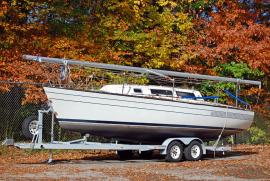
13 Biggest Trailerable Sailboats: Cheap But Good
Also - not all these boats are still in production, though they you can find them for sail used. Links are to the builder where possible, or to information pages to learn more if the builder is no longer around. Because we're looking at smaller boats, they won't likely be listed on brokerage sites, so you'll need to search for them on places like Craigslist, class association sites, and smaller regional boat sales sites and for sale boards.

On this page:
Com-pac eclipse, seaward 26rk, west wight potter (15 and 19), finding your boat.
First introduced in 1970, the Catalina 22 has been one of the most popular trailerable boats since its inception, though the Mk II update added a few inches of beam and couldn't race the Mk1 boats under one design class rules. The 22 Sport updates the classic original, while returning to the specifications for class legal racing out of the box with the original 22. It has a retractable lead keel, or an fixed keel option, and has berths below for up to four people. It's an easy weekender to launch and sail, with ready made fleets for fun, competitive racing.
Find the specs here
Com-Pac specializes in small, compact trailerable sailboats. The Eclipse is a solid example of their sloop-rigged boats. With a 21 foot overall length, 7'4" beam, and a 2,200 lbs displacement, it will tow easily with a modest vehicle. Down below, you'll find a double v-berth and space for cooking and food preparation. This converts to sleeping space with two additional quarter berths.
When looking for a trailerable pocket cruiser, look at the entire Com-Pac line.
Over five hundred CS 22 hulls were built in their production run in the early 70s, and this sturdy little cruiser is still a popular boat if you can find one on the used market. They conceived it as a lightweight, trailerable cruiser. It has a stubby externally ballasted keel with centerboard for added stability and pointing.
Though small, the interior has sleeping accommodations for four, a small galley, and a space for a portable toilet, making it a suitable choice for short expeditions and weekending. Though scarce today, the CS 22 is a good example of compact design that helped set the standard for later pocket cruisers.
The Flying Scot is a day sailer, and a popular design with over a hundred racing fleets around the U.S. It's an older design, having been in production for over fifty years, but this 19 foot sloop will still get a small group out on the water for a day of sailing and fun. Although it doesn't have an interior, clever and adventurous sailors have rigged up boom tents and other means to spend the night on their boats. Options on new boats include space for motor mounts, swim platforms, and higher end racing packages, and there is a strong market for parts and equipment.
The Hunter 22 is an updated replacement for the retired Hunter 216, another popular trailerable boat. The boat can be configured in a cruising setup with a V-berth and portable toilet, or a performance package with a sprit and asymmetrical spinnaker. For the size, it's a good value mini-cruiser with good performance and enough comfort to keep a small crew for a weekend. Depending how you configure your Hunter 22, it can run the gamut from comfy pocket cruiser to sporty day sailer.
Note: Hunter Marine changed names to Marlow-Hunter, though there is an enormous base of used boats with the Hunter brand.
There are several varieties of the MacGregor 26 beyond the base boat, including the 26D (1986-89), 26S (1990-95), 26X (1995-2003) and 26M (2002-2013). MacGregor boats have proven very popular trailerable boats, selling over 38,000 boats during the company's lifetime.
The Mac 26 differs from many small sailboats by two things - water ballast for stability, and the ability to take what is, by small sailboat standards, a massive outboard engine. A seventy horsepower engine on a 26' sailboat can make it hit planing speeds under power. This popular boat is a compromise - the water ballast, hull design, and smallish rig make it a somewhat underpowered sailboat, but it will sail. But if there is no wind, the Mac owners will still beat everyone back to the bar even while towing a water skier.
Their blend of form, function and design have made them controversial boats with experienced sailors, but there is no doubt the MacGregor 26 has gotten thousands of new boats on the water and built a loyal following for one of the most popular trailerable boats ever sold.
After the closure of MacGregor yachts, the Tattoo 26 was developed from the Mac 26 and is almost identical in performance capabilities and design.
Built at first with a fixed keel with an optional centerboard, orders for the keel/centerboard version outstripped the original and more centerboard versions were built. If you're looking for one, make sure it's the right version.
Lyle Hess and Jerry Montgomery designed the Montgomery 17 as a cruising capable, trailerable boat. The lapstrake fiberglass hull deflects spray and chop, and the 1,550 lb boat gives a stiff, dry sail. The cuddy cabin below has comfortable space for two adults, space for a portable toilet, and ample storage for gear and supplies. A four-part tackle rig makes raising the deck stepped a snap.
NorseBoats specializes in lighter day sailers and trailerable boats with a classic look but modern build and design concepts. Marketed as the "Swiss army knife" of boats, any of their offerings meet the criteria for an easy to trailer and handle boat with a shallow draft. The 17.5 can take a small outboard, has two rowing stations, and comes with a carbon fiber, rotating mast for easy setup and break down and solid performance under sail.
The larger NorseBoat 21.5 has an optional cabin version, with more sheltered space for sleeping and living than the open version.
The venture is a sixteen foot day sailer, and a modern design which can be sailed by up to eight people. The Venture has options for fixed keel, a centerboard, or a ballasted centerboard. As a forgiving design, it's a popular boat for inexperienced sailors and sail training, but still has enough power to be interesting and fun for skilled sailors as well. The RS Venture Connect features a lifting keel.
RS Sailing develops and sells many performance oriented small dinghies and day sailors aimed at a range of sailing skill and applications, from sail training dinghies to high performance racing skiffs.
Hand built with carbon fiber and vinylester resin over balsa core, this little boat is lighter than expected, but still sails well with options for a fixed keel or centerboard. At 16'10" overall, a 6'9" beam, and 1,300 lbs it's an easy boat to handle. But down below it's got a V-berth sized for adults and seating for two down below. The lapstrake designed hull deflects water and spray for a drier, more comfortable ride.
The smaller Sage 15 is another option for a lightweight boat using the same modern materials and techniques in a classically styled package.
The Seaward 26RK is the successor to Nick Hakes’ Seaward 25, with an edge to more comfort and better performance in a similar price to the last generation yacht. The result is the 26RK with more waterline, more buoyancy aft, and a lifting keel.
One of the larger boats on this list, the Seaward 26 RK, is still easy to move over land with a trailered weight under 6,000 pounds. The boat alone displaces 3,800 pounds, with 1,200 lbs. of that in retractable ballast with a bulb on the bottom. The keel lifts with an electric motor and is simple to operate. The cockpit is comfortable for four and has options for wheel or tiller steering.
Down below you'll find four six-foot berths and seating for four. Interior configurations include options for an enclosed head and v-berth, and a two-burner stove in a small galley.
Seaward Sailboats began sharing construction facilities with Island Packet Yachts and are sold through the same dealer network.
For over fifty years, the West Wight Potter has been a compact, trailerable option for a weekender and vacation boat. The fifteen and nineteen foot models have been fixtures at boat shows and in harbors, and sailors have even crossed oceans in these doughty little boats. The fifteen displaces only 475 pounds, with 165 pounds of ballast in the lifting keel. It's self righting and self bailing, with added foam for stability and floatation. The 19 is heavier at 1,225 pounds with 370 pounds of ballast, but the extra volume adds two more quarter berths, more headroom, space below, and more waterline.
With a kick up rudder and retracting keel, these little cruisers can be beached or taken in shallow waters. They designed the hull for stability and reduce spray for a dry and comfortable sail. Factory options include several creature comforts, sail options, and even trailers. With over 2,600 West Wight Potter 15s built and 1600 of the nineteen footer, there's a ready market of these pocket cruisers for sale.
While the big boats get the glory and high profile spots at the shows, smaller trailerable boats are what most people can buy. The corners of the shows where you see the West Wight Potters and Com-pacs to be just as exciting to me as the main docks filled with forty and fifty footers, because these smaller boats invoke a different adventure. An attainable adventure, for so many more people.
There's an array of smaller boats you can store in your garage or backyard and take out for everything from a casual day sail to a long summer vacation. This list gives you a flavor of what's out there in the trailerable boat market, but it's up to you to decide where you want to go and how you want to get here.
The article is headed by a photo of a S2 7.9 but that boat did not make your list. IMO the best trailer boat .
Leave a comment
You may also like, what is a swing or lifting keel 14 pros and cons explained.
If you need to know what a swing keel is, like me, this article is for you. I'm trying to decide what keel type is right for me, so I dove into the swing keel.
Sailboat Keel Types: Illustrated Guide (Bilge, Fin, Full)
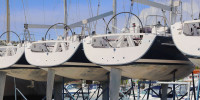
Centerboard (Swing Keel) vs. Fixed Keel: Pros and Cons
Own your first boat within a year on any budget.
A sailboat doesn't have to be expensive if you know what you're doing. If you want to learn how to make your sailing dream reality within a year, leave your email and I'll send you free updates . I don't like spam - I will only send helpful content.
Ready to Own Your First Boat?
Just tell us the best email address to send your tips to:
Daggerboard vs Centerboard: Choosing the Right Option for Your Sailboat
by Emma Sullivan | Aug 7, 2023 | Sailboat Maintenance
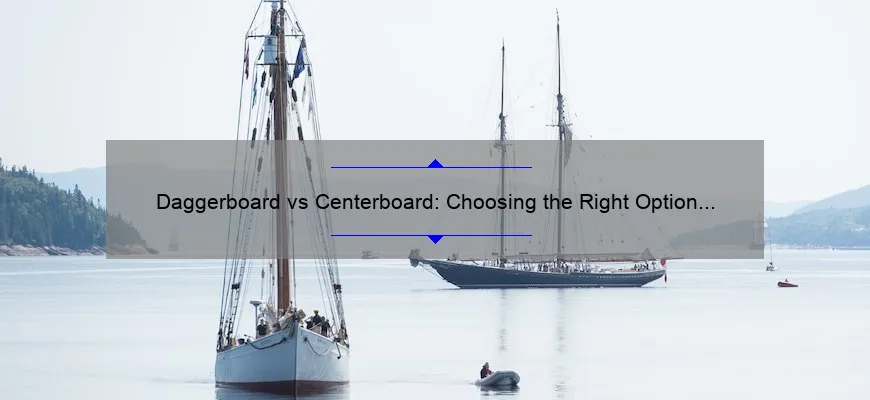
Short answer daggerboard vs centerboard:
A daggerboard is a retractable keel that can be raised or lowered vertically, providing stability and reducing sideways drift. On the other hand, a centerboard is also a retractable keel but pivots horizontally instead of vertically. While both serve similar purposes, their designs and mechanisms differ in terms of usage and effectiveness depending on the type and size of vessels they are used for.
Comparing Daggerboard vs Centerboard: What You Need to Know
Introduction:
When it comes to sailing, understanding the different types of boards used in sailboats is essential. Two commonly used boards are the daggerboard and centerboard . While both serve a similar purpose of providing stability and preventing lateral movement, there are a few key differences between these two options. So, let’s dive deeper into comparing daggerboards versus centerboards to shed some light on what you need to know.
1. Definition:
To start with, let’s define each board type. A daggerboard is a retractable keel that can be raised or lowered vertically through a slot in the hull of a sailboat. On the other hand, a centerboard is also an adjustable keel-like appendage but pivots around a single point when lifted out of the water .
2. Functionality:
The primary function of both boards is to counteract the sideways forces generated by wind acting on the sails and maintain stability in the water. However, they achieve this goal using slightly different mechanisms.
With a daggerboard, sailors have more control over adjusting its depth as it can be raised or lowered at will. This allows them to fine-tune their boat’s performance according to wind conditions and desired speed.
On the contrary, centerboards offer less adjustability and usually have set positions determined by design. Nevertheless, they still provide adequate lift and resistance against sideways drift while sailing close-hauled or upwind.
3. Performance:
When it comes to performance comparison between these two options, both have their pros and cons depending on factors such as boat size, sail plan, and intended use.
Daggerboards generally provide superior upwind performance due to their ability to be adjusted for various wind angles precisely. They allow sailors to optimize for maximum lift while minimizing drag in challenging conditions like gusty winds.
Centerboards excel in downwind sailing situations where maintaining optimal balance becomes critical. Their fixed position contributes additional stability during fast runs or when navigating waves, making them a favorable choice for racing scenarios or larger sailboats .
4. Construction and Maintenance:
Another aspect to consider is the construction and maintenance of these boards. Daggerboards are often made from materials such as fiberglass, carbon fiber, or wood laminates, requiring periodic inspection for wear and tear. However, they can be easily removed during maintenance or storage.
Centerboards are commonly built using similar materials but differ in their pivot point mechanism. The pivot offers simplicity and fewer moving parts that could potentially fail over time. Nonetheless, periodic inspections are still recommended to ensure the board remains secure within its casing.
5. Adaptability:
For sailors who enjoy exploring various water conditions, adaptability becomes a significant factor when comparing daggerboards and centerboards.
Daggerboards prove to be more versatile in this regard as their adjustability allows for experimentation with different sailing techniques on changing water types. This attribute makes them particularly suitable for sailors looking to venture into both shallow waters and deeper offshore locations while keeping their vessel stable.
Centerboards, although limited in terms of adjustability, offer reliability and ease of use across a wide range of sailing environments. They work exceptionally well for recreational sailors who primarily navigate deepwater areas without the need for frequent adjustments.
Conclusion:
In conclusion, understanding the differences between daggerboards and centerboards is crucial when considering which option best suits your sailing needs. While daggerboards provide greater performance optimization capabilities across wind angles and various conditions, centerboards offer stability and reliability in both recreational cruising and racing scenarios.
Ultimately, it’s essential to carefully evaluate your requirements based on boat type, desired performance characteristics under specific weather conditions, as well as personal preferences before making a decision between these two distinct but equally valuable options: the versatile daggerboard or steadfast centerboard.
Understanding the Difference: A Step-by-Step Guide to Daggerboards and Centerboards
If you’re passionate about sailing or have recently taken up the sport, you might have come across the terms “daggerboard” and “centerboard.” While these two components are integral to a sailboat ‘s performance, their roles and characteristics can sometimes be confusing. In this comprehensive guide, we will take you step-by-step through everything you need to know about daggerboards and centerboards – shedding light on their differences and helping you make informed decisions for your own sailing adventures.
First things first, let’s define both daggerboards and centerboards. Both of these structures are essentially appendages that extend from the hull beneath a sailboat. They serve a shared purpose: providing lateral resistance against the force of the wind, preventing the boat from being blown sideways while allowing it to move forward effectively. However, there are distinct variations in design, functionality, and usage between them.
Let’s start with daggerboards. As their name suggests, these boards resemble daggers due to their shape – long and narrow blades that slide vertically into slots in a boat’s hull. Typically located amidships or towards the stern of a vessel, daggerboards are commonly used in high-performance racing yachts or catamarans . Their primary function is to counteract the sideways force generated by wind acting on sails positioned away from where they attach to the mast – an effect known as “lee helm.” By adjusting or deploying multiple daggerboards asymmetrically, sailors can optimize their boats’ performance by minimizing drag while maximizing lift.
On the other hand, centerboards serve a similar purpose but differ significantly in design and usage compared to daggerboards. Unlike fixed daggerboads that slide vertically into slots within a hull structure permanently mounted on a boat’s keel or inside its hull at centreline position (often hollow), centerboard systems rely on pivoting mechanics and vertical movement.
To put it simply, centerboards pivot around a fulcrum or a pin attached to the hull, allowing them to be raised or lowered as needed. They are often found in sailboats designed for recreational purposes – such as small dinghies, daysailers, or even some keelboats. Centerboards can be retracted fully into the hull for shallow-water sailing and ease of launching or landing – an especially useful feature when dealing with beach landings. When lowered into position, they provide similar lateral resistance as daggerboards but typically offer less efficiency due to their simplified shape and lesser surface area.
Now that you understand the basic concepts behind daggerboards and centerboards, let’s explore their advantages and considerations. Daggerboards excel in providing substantial lateral resistance and increased lift capability due to their more refined shape and positioning options. The ability to adjust multiple daggerboards asymmetrically can lead to improved performance under varying wind conditions, making these boards indispensable for competitive sailors seeking optimal speed.
In contrast, centerboards are known for their versatility and convenience. Their pivoting mechanism enables them to be easily raised or lowered while on the water – a valuable asset when navigating shallow waters without risking damage or grounding the boat. Moreover, many small sailboats with centerboard designs also benefit from enhanced stability since the board’s weight aids in counteracting heeling forces acting on the sails.
When choosing between a daggerboard setup or a boat equipped with a centerboard system, several factors come into play. Firstly, consider your sailing intentions: are you primarily interested in casual cruising, racing competitively with precise maneuvering requirements or something in-between? Secondly, assess your local sailing conditions: do you frequently encounter challenging wind patterns or navigate areas with shallow waters ? These aspects will help steer you towards the most suitable option for your needs.
Ultimately, whether you opt for a sailboat equipped with a daggerboard system or one featuring a centerboard mechanism depends on various factors, including performance goals, sailing preferences, and intended use. Don’t hesitate to consult with experienced sailors, boat designers, or reputable manufacturers to ensure you make the right choice.
In conclusion, understanding the key differences between daggerboards and centerboards empowers sailors to select the appropriate configuration for their specific needs while navigating diverse sailing environments. Both appendages play crucial roles in enhancing sailboat stability and maneuverability, but their designs and functionalities vary significantly. Take into account your sailing aspirations and local conditions when making a decision – ensuring an enjoyable and successful experience on the water !
FAQ: Decoding the Pros and Cons of Daggerboards vs Centerboards
Title: FAQ: Decoding the Pros and Cons of Daggerboards vs Centerboards for Smooth Sailing
Introduction: Ahoy, fellow boating enthusiasts ! As you venture into the exciting world of sailing, one critical decision awaits you on your quest to harness the wind’s power. Today, we dive deep into deciphering the age-old conundrum—daggerboards or centerboards? Strap on your life vests as we embark on a journey to unravel the pros and cons of these two remarkable appendages that determine our vessel’s stability and maneuverability.
1. Understanding Daggerboards: Daggerboards, like stealthy underwater swords, elegantly slice through waters beneath our hulls. These vertically retractable boards are typically found in high-performance sailboats, optimized for speed and agility. But what makes daggerboards such an enticing choice?
Advantages of Daggerboards: a) Enhanced Speed: When engaged correctly, daggerboards create less drag compared to fixed keels or centerboards while maintaining lateral resistance. This enables your vessel to cut through water with minimal resistance, giving you a serious edge in speed races. b) Improved Upwind Performance: Daggerboards lend invaluable assistance in maximizing upwind sailing angles by resisting leeway—a fantastic asset when navigating against adverse currents or winds . c) Advanced Maneuverability: The ability to raise and lower these boards allows for easy adaptation to different sailing conditions without limiting boat movement possibilities.
Disadvantages of Daggerboards: a) Costly Investment: Opting for daggerboard-equipped vessels may lead to a higher upfront investment due to their intricate design and construction. b) Maintenance Complexities: Attending to daggerboard mechanisms demands regular inspection and occasional repairs; proper care is essential for long-term performance . c) Limited Draft Range: Some sailors argue that daggerboards hinder access to shallow waters due to their deeper draft range compared to centerboards.
2. Unveiling Centerboards’ Secrets: Now, let’s dive into the undeniable allure of centerboards—a versatile alternative that has carved its place in the sailing community. Positioned within a sailboat’s hull, these retractable appendages offer unique advantages worth considering.
Advantages of Centerboards: a) Versatility: The retractable nature of centerboards allows for easy maneuvering in shallow waters or when navigating close to shore. No more worrying about running aground! b) Cost-efficiency: Boats with centerboards tend to be more affordable compared to their daggerboard-equipped counterparts, making them an attractive choice for budget-conscious sailors . c) Simplicity in Maintenance: With fewer moving parts and mechanisms, the maintenance requirements for centerboards are often less complex and demanding.
Disadvantages of Centerboards: a) Compromised Performance: Sailing aficionados argue that centerboards might sacrifice performance compared to daggerboards due to increased drag and reduced lateral resistance. b) Limited Upwind Performance: When faced with strong winds or currents pushing against your vessel, centerboards may struggle to maintain course stability effectively.
Conclusion: Now that we’ve embarked on this quest through the pros and cons of daggerboards versus centerboards, it’s time for you to weigh your options carefully. Consider factors like your desired sailing style, local water conditions, budget constraints, and long-term maintenance commitments. Remember, whether you opt for the sleek agility of daggerboards or the versatile adaptability of centerboards—safe voyages and thrilling adventures await as you navigate through uncharted waters!
Exploring the Advantages of Daggerboards and Centerboards in Sailing
Are you an avid sailor or someone looking to dip their toes into the exhilarating world of sailing ? If so, understanding the advantages that daggerboards and centerboards provide can significantly enhance your sailing experience. These essential components are not only cleverly designed but also play a paramount role in improving a sailboat’s performance on the water . In this blog post, we will delve into the details of these devices, uncovering their remarkable benefits.
Firstly, let’s start by demystifying what daggerboards and centerboards actually are. Both of these apparatuses serve the same purpose – they stabilize a sailboat by providing lateral resistance, preventing it from drifting sideways due to wind pressure. However, they accomplish this task through different mechanisms.
Daggerboards are retractable foils that typically slide vertically from within the hull. These appendages are often found on high-performance racing boats as they offer numerous advantages. One notable advantage is their ability to maximize speed by minimizing hydrodynamic drag. When deployed correctly, daggerboards reduce sideways drift and lift the boat out of the water slightly, reducing wetted surface area and frictional resistance – resulting in enhanced speed through the water .
Additionally, daggerboards have another trick up their sleeve – adjustable angle-of-attack. Sailors can fine-tune these boards to suit different wind conditions, allowing for optimal performance based on variable factors such as wind strength or direction. This adaptability ensures that you are always at an advantage when facing changing weather conditions during races or leisurely sails.
On the other side of things, centerboards – unlike daggerboards – pivot horizontally from within the hull towards the boat’s midline. Although they lack some of the advantages provided by daggerboards regarding drag reduction and adjustment capabilities, centerboards excel in versatility and accessibility.
One significant advantage that centerboards offer is their ability to navigate shallow waters easily. You’ll find these boats cruising close to shorelines and in areas where draft limitations exist, such as lakes, rivers, or even windy coastal havens with numerous sandbanks. The retractable nature of centerboards allows sailors to raise them fully when entering shallow waters, minimizing the risk of grounding the boat while still maintaining excellent balance and control .
Furthermore, the positioning of a centerboard closer to the boat’s center of mass assists in preventing excessive heeling (tilting) during sailing . For those new to sailing or those who prefer a more stable ride, this can provide a greater sense of safety and security on the water.
In conclusion, both daggerboards and centerboards bring distinct advantages to sailboat enthusiasts. Daggerboards offer improved hydrodynamics for speed enthusiasts while providing adjustability for varying wind conditions – perfect for competitive racing or achieving top-notch performance. On the other hand, centerboards excel in versatility by allowing sailors access to shallow waters without sacrificing stability.
Whether you’re aiming for podium finishes in a regatta or simply seeking an invigorating recreational experience on the water, having a good understanding of these vital components will undoubtedly elevate your sailing adventures . So next time you hoist those sails and feel the saltwater spray on your face, appreciate how these cleverly designed daggerboards and centerboards optimize your vessel’s performance, granting you unparalleled control and enjoyment throughout every voyage.
How to Choose Between a Daggerboard and a Centerboard for Your Sailboat
Choosing the right type of board for your sailboat is a crucial decision that can greatly impact your sailing experience. Two popular options are the daggerboard and the centerboard , each with its own unique advantages and considerations. In this blog post, we will delve into the intricacies of these two board types to help you make an informed choice for your vessel.
Let’s start by understanding what a daggerboard and a centerboard actually are. Both are vertical boards positioned in the keel to provide stability and prevent sideways drift. The primary difference lies in their configuration and functionality.
1. Daggerboards: Imagine a dagger slicing through water with precision – that’s precisely how daggerboards operate! These long, narrow boards are fully retractable, typically made from high-strength materials like fiberglass or carbon fiber. They offer excellent hydrodynamic efficiency, leading to enhanced upwind performance and minimizing leeway (sideways drift) during sailing .
Why opt for a daggerboard? Well, if you’re passionate about racing or want to explore faster sailing speeds, daggerboards should top your list. With their ability to be raised or lowered at will, they allow countless adjustment possibilities while on the water – from optimizing your boat ‘s balance based on wind conditions to maneuvering through shallow waters without worrying about grounding.
However, there are some drawbacks worth considering before committing to a daggerboard. Due to their intricate design and construction, they tend to be more expensive than centerboards. Additionally, retracting them may require physical effort or even hydraulic assistance on larger vessels.
2. Centerboards: Centerboards share similar functionality as daggerboards but differ in construction and operation. Unlike daggerboards that slide vertically within casing built into the hull of the sailboat, centerboards pivot horizontally from its midpoint inside the hull itself.
So why go for a centerboard instead? Primarily known for their versatility and adaptability across various boat types – dinghies, daysailers, or cruisers – centerboards provide easy access to shallow waters. As they pivot up into the hull, the sailboat’s draft decreases, allowing you to explore areas that would otherwise remain inaccessible.
If budget constraints are a concern, opting for a centerboard might be more economical compared to a daggerboard . They are generally simpler in design and easier to maintain due to their horizontal movement mechanism.
Nevertheless, keep in mind that centerboards may compromise your sailing performance slightly. Although they perform reasonably well upwind and allow sailing closer to the wind than boats without any keel at all (known as leeboards), they are not as efficient as daggerboards when it comes to performance-oriented sailing.
In conclusion, choosing between a daggerboard and a centerboard ultimately depends on your specific requirements and intended use of the sailboat. If you crave exhilarating speeds, impeccable upwind capabilities, and have room in your budget for a high-performance board, go for a daggerboard without hesitation. On the other hand, if versatility, cost-effectiveness, and shallow-water exploration take precedence over pure speed obsession, opt for a centerboard.
Remember that regardless of which board you choose; practice and experience will play crucial roles in mastering its deployment and optimizing its effect on your sailing adventures . Happy cruising!
Going Beyond Basics: Mastering the Use of Daggerboards vs Centerboards
Title: Going Beyond Basics: Mastering the Art of Daggerboards vs Centerboards
Introduction: When it comes to sailing, achieving optimum performance requires more than just a basic understanding of the equipment. To truly excel in this beautiful sport, sailors need to delve deeper into the intricacies of their vessel’s components. One such critical component is the choice between daggerboards and centerboards. In this blog post, we will explore these options in detail, shedding light on their characteristics, benefits, and how mastering their use can take your sailing skills to new heights.
The Difference Between Daggerboards and Centerboards: Before we dive into their nuances, let’s begin by understanding the fundamental difference between daggerboards and centerboards. Both are retractable fins intended to prevent leeway (sideways drift) when sailing against the wind . The primary variation lies in their location on the hull. Daggerboards are inserted vertically through slots located towards the middle of each hull side on catamarans or near the keel area on monohulls. Conversely, centerboards are mounted on pivots below the hull at its central point.
Daggerboard Dominance: 1. Performance Advantages: Daggerboards provide sailors with remarkable advantages when it comes to sailboat performance. Their vertical positioning allows for reduced drag and enhanced lift characteristics compared to centerboards. 2. Upwind Sailing Power: Due to their dynamic design, daggerboards enable better upwind sailing as they can be further extended downwards into deeper water when necessary – increasing resistance against being pushed sideways by wind pressure. 3. Higher Speed Potential: By reducing leeway during upwind maneuvers, daggerboard-equipped boats experience less resistance and consequently achieve higher speeds. 4. Enhanced Steering Control: Another noteworthy benefit of daggerboard usage is improved steering control under demanding conditions like strong winds or rough seas.
Centerboard Superiority: 1. Versatility across Depths: Compared to daggerboards that require specific water depths, centerboards allow sailors to venture into shallower waters. The ability to raise the centerboard partially or completely reduces grounding risks and grants access to areas otherwise inaccessible. 2. Simplified Maneuverability: With a fixed pivot point across all wind conditions, centerboards are more straightforward and hassle-free to operate. Their stability provides consistent performance, making sailing a breeze for beginners and less experienced crews. 3. Safety in Grounding Situations: In the unfortunate event of running aground, a centerboard is designed to kick up easily upon contact with solid objects, minimizing potential damage to both the board and the hull.
Mastering Daggerboards vs Centerboards: 1. Understanding Conditions: To make an informed choice between daggerboards and centerboards, it’s crucial to assess the predominant sailing conditions you encounter. For open-water excursions where speed reigns supreme, daggerboards are often favored. Conversely, if your voyages take you through varied depths or potentially shallow areas, a centerboard may be more advantageous. 2. Gradual Familiarization & Practice: Like any skill in sailing, mastering the use of daggerboards or centerboards necessitates practice and experimentation. Sailors who wish to truly harness these components should gradually familiarize themselves with how they influence the boat’s performance by adjusting their depth according to wind strength and direction. 3. Seek Expert Guidance: Advanced sailors seeking technical expertise can benefit from reaching out to experienced professionals or participating in sailing clinics focused on advanced techniques involving daggerboard or centerboard utilization.
Conclusion: In summary, going beyond the basics of sailing involves mastering intricate aspects such as choosing between daggerboards and centerboards. Each has unique advantages catering to different sailing scenarios and personal preferences. By honing your understanding of these components’ functionality along with practice at utilizing them optimally under varying conditions enable sailors to unlock remarkable improvements in speed, maneuverability, and control – elevating their overall proficiency in the art of sailing.
Recent Posts

- Sailboat Gear and Equipment
- Sailboat Lifestyle
- Sailboat Maintenance
- Sailboat Racing
- Sailboat Tips and Tricks
- Sailboat Types
- Sailing Adventures
- Sailing Destinations
- Sailing Safety
- Sailing Techniques
Choosing a Centerboard or Fixed Keel Sailboat
- Snowboarding
- Scuba Diving & Snorkeling
Centerboard or Fixed Keel?
You need to consider many different questions when deciding what kind of sailboat is best for you .
Depending on the general size range of the sailboats you may be interested in, you may need to choose between fixed-keel boats and centerboard (or swing keel or daggerboard) boats. This article will help you choose which is best for your needs.
As only a very general rule, most sailboats over 20-something feet have fixed keels. Most sailboats under 15 feet or so have centerboards. But there is a wide range of boats from 12 to about 25 feet with either a fixed keel or a centerboard. For example, in this photo, the boat on the left has a fixed keel, while the boat on the right, of about the same size, has a centerboard.
If you are shopping for a sailboat in this range, you should understand the differences between these fundamental types of keels.
Fixed Keel Sailboats
Virtually all large racing and cruising sailboats have a fixed keel. A keel is needed to keep the boat from being blown sideways at all points of sail except downwind. A keel also provides weight low under the water to lower the boat’s center of gravity below the waterline, which is needed so that the boat bobs back upright if knocked over by wind or waves.
Sailboats have many different types of fixed keels , such as full keels (see photo) and fin keels. If you decide a fixed keel boat is best for your sailing purposes, consider also which type keel best meets your needs.
Centerboard Sailboats
On centerboard sailboats, the centerboard functions like a keel to keep the boat from being blown sideways. (All sailboats need a keel of the board for this reason: the narrow, flat surface of the board or keel produces little drag when the boat moves forward but resists motion sideways.)
The centerboard usually hangs down below the hull from a pivot at one end. It can be raised by pulling a line that swings the centerboard up into a centerboard trunk along the center of the boat, as shown in the photo.
Some small boats, like a Sunfish, have a removable daggerboard rather than a centerboard. The daggerboard has the same function, but rather than swinging down, it is inserted like a blade down through a slot in the hull to protrude like a thin keel below the hull. A swing keel is another term used for a type of keel that like a centerboard can be raised.
A centerboard may or may not be weighted. If the centerboard is weighted, then it also provides weight low in the water, like a keel, to help keep the boat upright (although not as much weight as a fixed keel can supply). If the centerboard is not weighted, like the fiberglass centerboards of many small sailboats, then sailors must keep the boat upright by positioning their own weight on the upwind side of the boat.
Benefits and Disadvantages of Fixed Keel and Centerboard Sailboats
Fixed keels and centerboards each have their own benefits but also disadvantages. When deciding what type of boat to buy, be sure you have considered these differences:
Advantages of a Fixed Keel:
- Provides the most ballast to resist capsizing and ensure recovery from a capsize
- More effective at preventing leeway (sideways movement of the boat)
- Crew do not have to position body weight to prevent capsizing (see photo)
- No centerboard moving parts to break or jam
Disadvantages of a Fixed Keel:
- With deeper displacement, the boat cannot enter shallow water
- The boat is heavier for its size (usually an issue only when trailering)
- With deeply fixed keels, the boat may not fit on a trailer at all (25 feet is typically the largest trailerable fixed keel sailboat) - requiring the inconvenience and expense of a boatyard for launching, haulout, and storage
Advantages of a Centerboard:
- The centerboard can be raised to decrease displacement to allow the boat into shallower water – and it should swing up and back if it hits the bottom when sailing with it down
- The centerboard can be raised for faster downwind sailing
- The centerboard can be partially raised if needed to provide better boat balance
- Most centerboard boats can be trailered and easily launched and hauled out on boat ramps (larger centerboard boats may require deeper ramps)
A popular trailerable centerboard sailboat is the MacGregor 26 , which with its water ballast has the advantages of centerboard boats but not all the disadvantages.
Disadvantages of a Centerboard:
- Provides no (unweighted board) or less (weighted board) ballast, compared to a fixed keel, to resist capsizing and ensure recovery from a capsize
- Less effective than a larger fixed keel at preventing leeway (sideways movement of the boat)
- The centerboard trunk takes up space in the boat’s cockpit or cabin
- The centerboard pivot and control line involve moving parts and can jam or break
Finally, some historic crafts have leeboards instead of centerboards; these boards, mounted outside the hull on both sides, can be pivoted down like a centerboard to resist leeward motion. And some sailboats have fixed keel-centerboard combinations, which provide ballast and prevent leeward motion even when the centerboard is up but also provide the option to attain less leeward motion sailing upwind when the board is down.e a centerboard to resist leeward motion. And some sailboats have fixed keel-centerboard combinations, which provide ballast and prevent leeward motion even when the centerboard is up but also provide the option to attain less leeward motion sailing upwind when the board is down.
- Learn How to Sail a Small Sailboat – 1. The Parts of the Boat
- Choosing an Inboard or Outboard Engine
- How to Gybe a Sailboat
- How to Heave To a Sailboat
- How to Raise the Mainsail
- The Sunfish: A Perfect Lake or Urban Sailboat
- Best Sailing and Boating Apps
- Using AIS on Your Sailboat
- How to Tow a Dinghy Behind a Sailboat
- Review of Lehr Propane Outboard Engine
- The Types of Sailboat Rudders
- Correct Scope is Essential for Safe and Comfortable Anchoring
- How to Anchor a Sailboat
- How to Use a Mainsheet Traveler
- How to Tack a Sailboat
- A Guide to Properly Baiting Spotted Sea Trout
- BOAT OF THE YEAR
- Newsletters
- Sailboat Reviews
- Boating Safety
- Sailing Totem
- Charter Resources
- Destinations
- Galley Recipes
- Living Aboard
- Sails and Rigging
- Maintenance
- Best Marine Electronics & Technology

20 Best Small Sailboats for the Weekender
- By Mark Pillsbury
- Updated: August 4, 2021
In order to go cruising, most of us require a sailboat with a head, a galley, and bunks. The boat, likely a 30-footer and more often a 40-footer, will have electronics for navigation and entertainment, refrigeration if the trip is longer than a coastal hop, an engine for light wind, and, depending on our appetites for food and fun, perhaps a genset to power our toys and appliances.
To go sailing , however, all we really need is a hull, mast, rudder, and sail. To experience the pure joy of sheeting in and scooting off across a lake, bay, or even the open ocean, there’s nothing better than a small sailboat – we’re talking sailboats under 25 feet. You can literally reach out and touch the water as it flows past. You instantly feel every puff of breeze and sense every change in trim.
Some of the boats in this list are new designs, others are time-tested models from small sailboat manufacturers, but every one is easy to rig, simple to sail, and looks like a whole lot of fun either for a solo outing on a breezy afternoon or to keep family and friends entertained throughout your entire sailing season. This list is made up of all types of sailboats , and if you’re looking for a list of some of the best small sailboats for beginners, you’ll find exactly that here.
Any one of these popular boats could be labeled as a trailerable sailboat, daysailer, or even a weekender sailboat. And while most would be labeled as a one or two person sailboat, some could comfortably fit three or even four people.
Marblehead 22 Daysailer
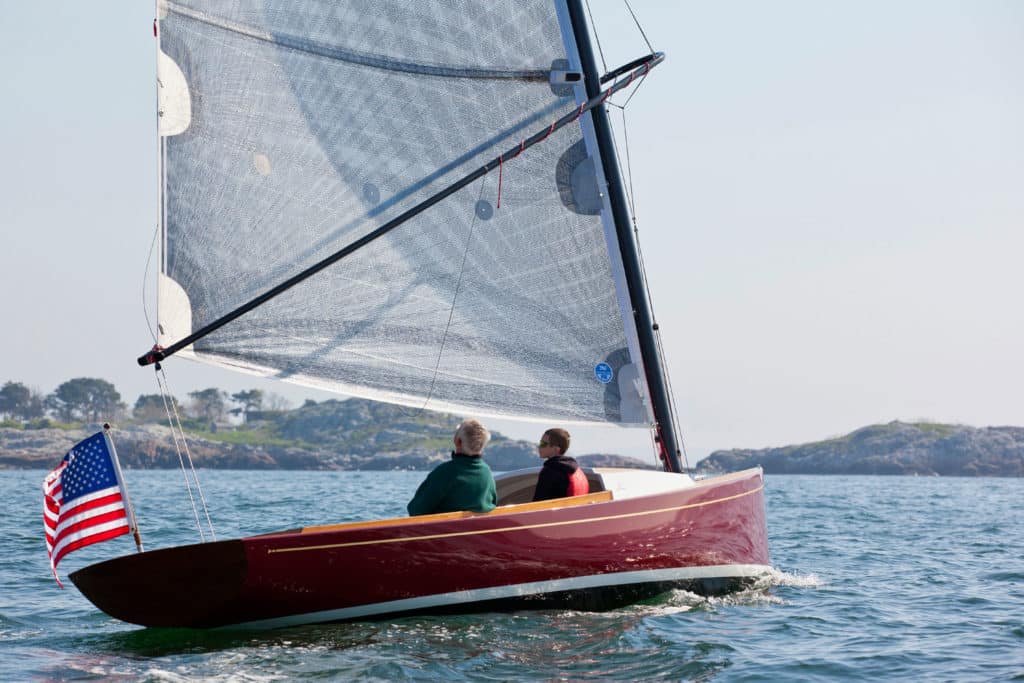
If you have an eye for elegant lines and your heart goes pitter-patter over just the right amount of overhang beneath a counter transom, the Marblehead 22 daysailer, designed by Doug Zurn and built by Samoset Boatworks in Boothbay, Maine, will definitely raise your pulse. Traditional-looking above the waterline and modern beneath, the cold-molded hull sports a deep bulb keel and a Hall Spars carbon-fiber mast with a wishbone rig and square-top main. The 11-foot-9-inch cockpit can seat a crowd, and a small cuddy forward will let you stow your friends’ gear for the day. samosetboatworks.com
Catalina 22 Sport
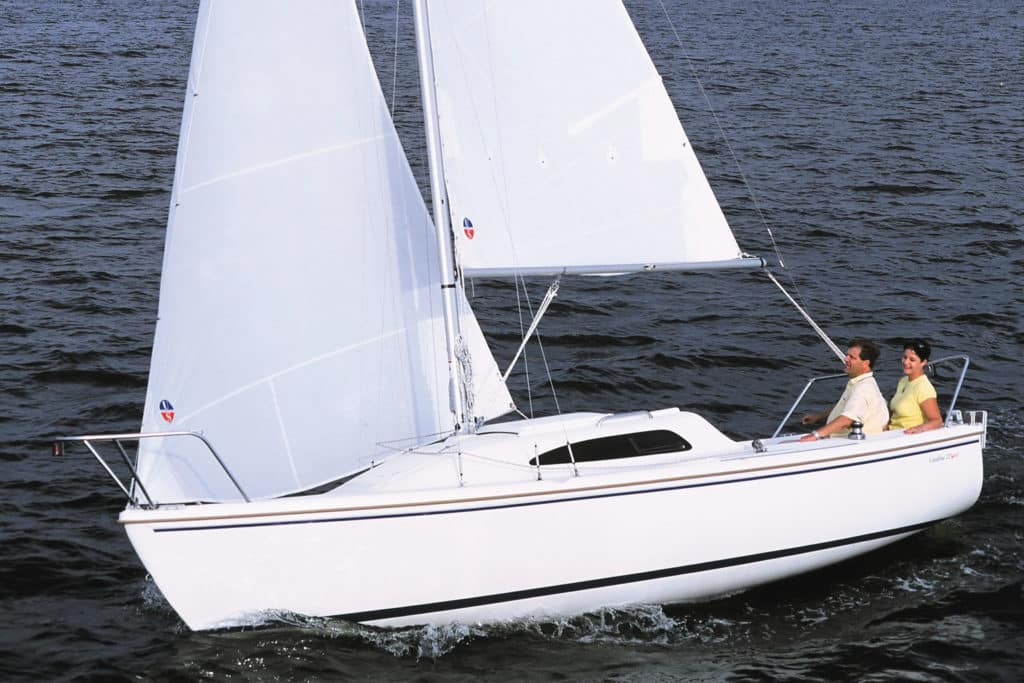
Many a harbor plays host to an active fleet of Catalina 22s, one of the most popular small sailboats over the years, given its basic amenities and retractable keel, which allows it to be easily trailered. Recently, the company introduced the Catalina 22 Sport, an updated design that can compete with the older 22s. The boat features a retractable lead keel; a cabin that can sleep four, with a forward hatch for ventilation; and a fractional rig with a mainsail and a roller-furling jib. Lifelines, a swim ladder, and an engine are options, as are cloth cushions; vinyl cushions are standard. The large cockpit will seat a crowd or let a mom-and-pop crew stretch out and enjoy their sail. It’s clear why the Catalina 22 is one of the best sailboats under 25 feet. catalinayachts.com
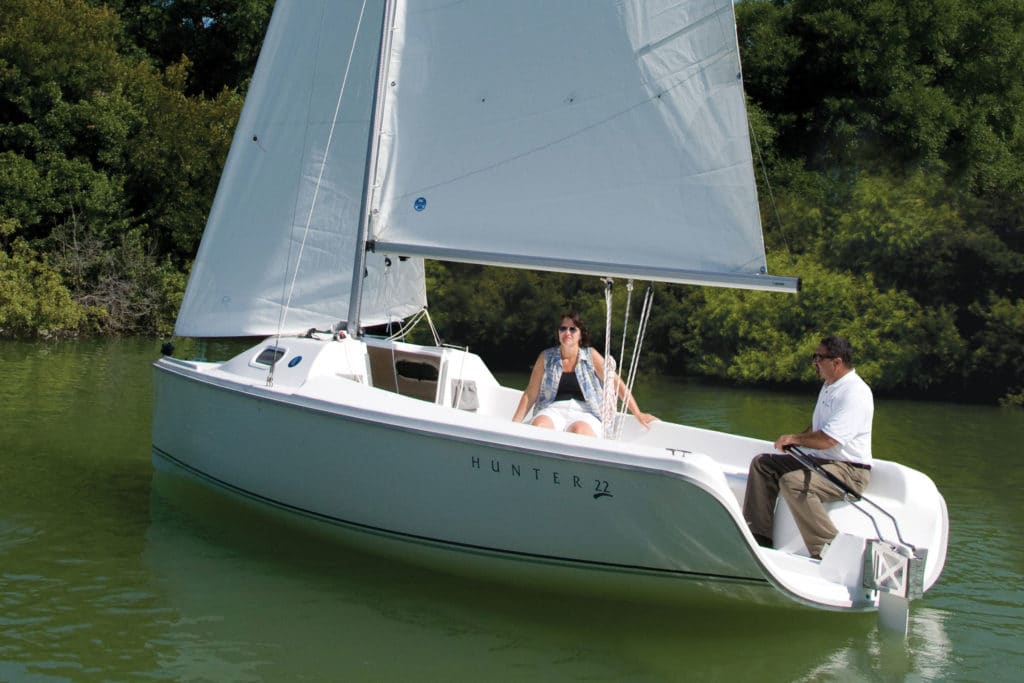
With its large, open-transom cockpit and sloop rig, the Hunter 22 makes a comfortable daysailer for family and friends. But with its cuddy cabin, twin bunks, optional electrical system, opening screened ports, and portable toilet, a parent and child or a couple could comfortably slip away for an overnight or weekend. Add in the optional performance package, which includes an asymmetric spinnaker, a pole, and a mainsheet traveler, and you could be off to the races. The boat features a laminated fiberglass hull and deck, molded-in nonskid, and a hydraulic lifting centerboard. Mount a small outboard on the stern bracket, and you’re set to go. marlow-hunter.com
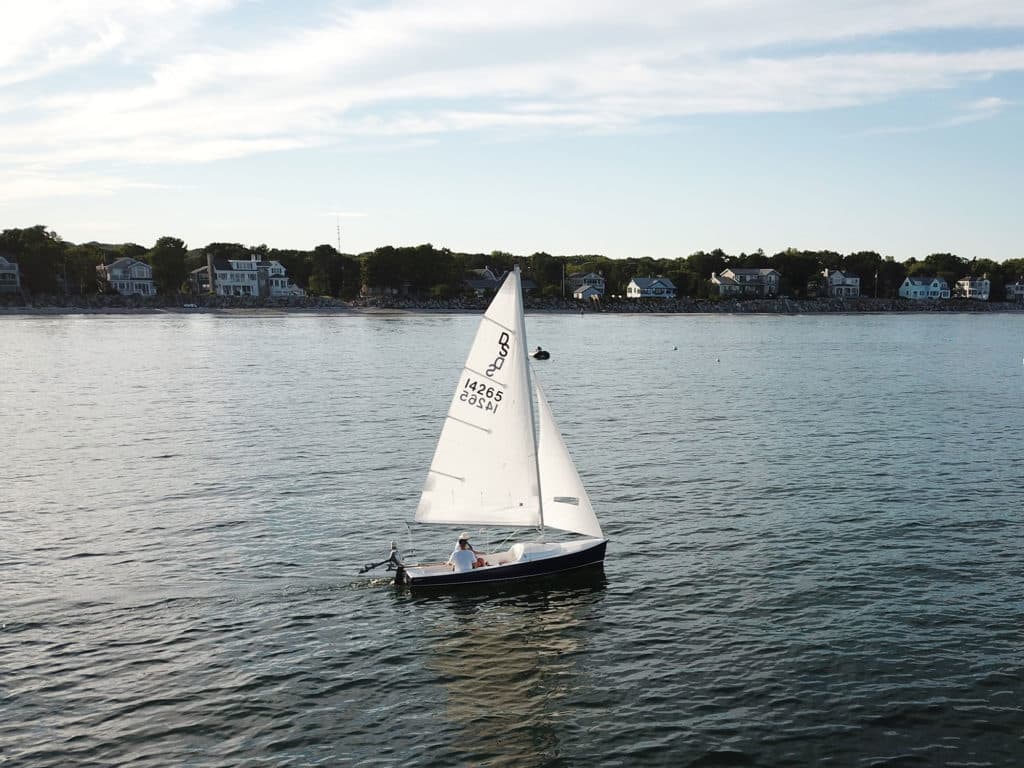
Not sure whether you want to race, cruise or just go out for an afternoon sail? Since 1958, sailors have been having a ball aboard the Uffa Fox/George O’Day-designed Daysailer. Fox, who in the 1950s was on the cutting edge of planning-dinghy design, collaborated with Fall River, Massachusetts boatbuilder O’Day Corp. to build the 16-foot Daysailer, a boat that features a slippery hull and a small cuddy cabin that covers the boat roughly from the mast forward. Thousands of Daysailers were built by various builders, and they can be found used for quite affordable prices. There are active racing fleets around the US, and new Daysailers are still in production today, built by Cape Cod Ship Building. capecodshipbuilding.com
BayRaider from Swallow Boats
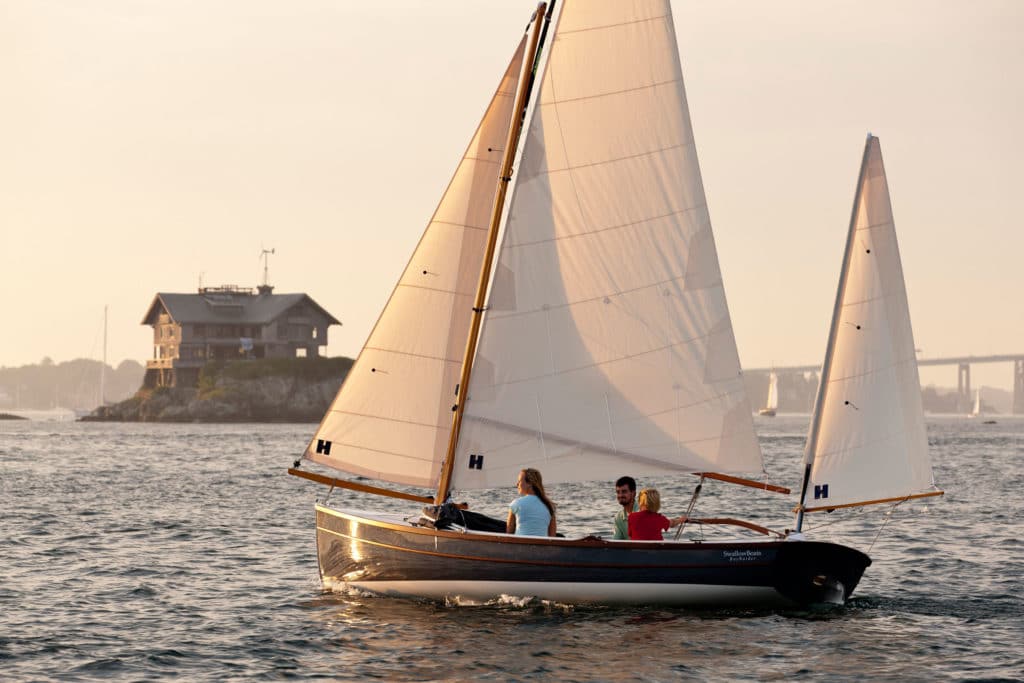
Easy to rig and trailer, the BayRaider from England’s Swallow Yachts is a relative newcomer to the small-boat market in the United States. Nearly all of its 19 feet 9 inches is open cockpit, though a spray hood can be added to keep the forward sections dry. The BayRaider is ketch-rigged with a gunter-style mainmast. The topmast and mizzen are both carbon-fiber, which is an option for the mainmast as well. The BayRaider can be sailed with a dry hull in lighter conditions or with 300 pounds of water ballast to increase its stability. With the centerboard and hinged rudder raised, the boat can maneuver in even the thinnest water.
$28,900, (904) 234-8779, swallowyachts.com
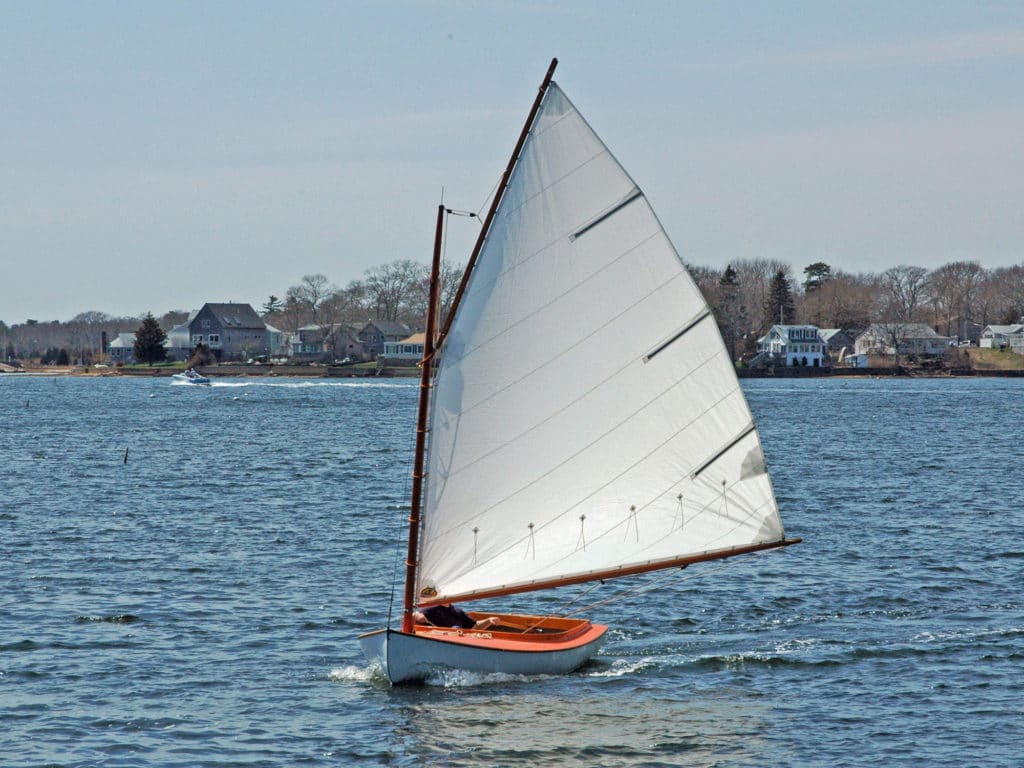
Big fun can come in small packages, especially if your vessel of choice happens to be the 12 ½-foot Beetle Cat. Designed by John Beetle and first built in 1921, the wooden shallow draft sailboat is still in production today in Wareham, Massachusetts at the Beetle Boat Shop. With a draft of just 2 feet, the boat is well-suited for shallow bays, but equally at home in open coastal waters. The single gaff-rigged sail provides plenty of power in light air and can be quickly reefed down to handle a blow. In a word, sailing a Beetle Cat is fun. beetlecat.com
West Wight Potter P 19
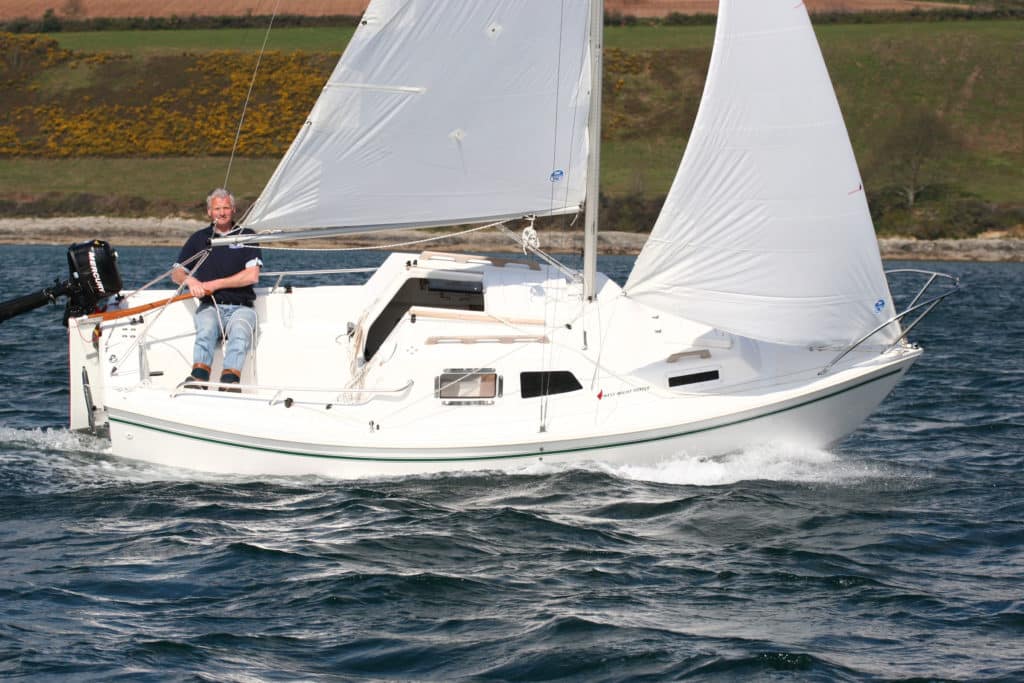
With berths for four and a workable galley featuring a cooler, a sink, and a stove, West Wight Potter has packed a lot into its 19-foot-long P 19. First launched in 1971, this is a line of boats that’s attracted a true following among trailer-sailors. The P 19′s fully retractable keel means that you can pull up just about anywhere and go exploring. Closed-cell foam fore and aft makes the boat unsinkable, and thanks to its hard chine, the boat is reportedly quite stable under way. westwightpotter.com
NorseBoat 17.5
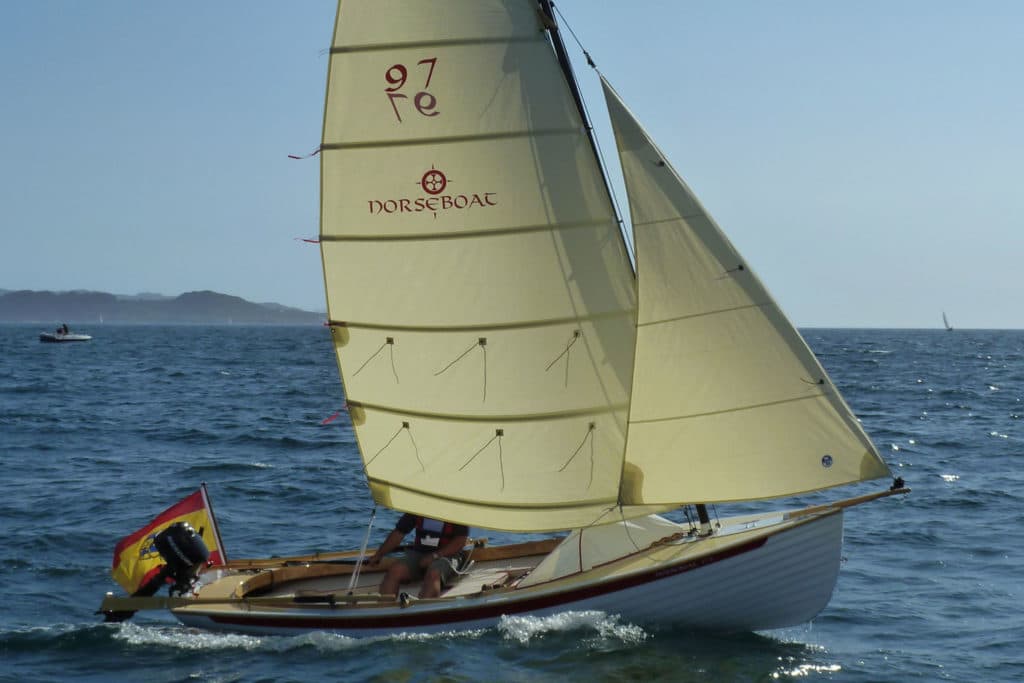
Designed for rowing and sailing (a motor mount is optional), the Canadian-built NorseBoat 17.5—one of which was spotted by a CW editor making its way through the Northwest Passage with a two-man crew—features an open cockpit, a carbon-fiber mast, and a curved-gaff rig, with an optional furling headsail set on a sprit. The lapstrake hull is fiberglass; the interior is ply and epoxy. The boat comes standard with two rowing stations and one set of 9-foot oars. The boat is designed with positive flotation and offers good load-carrying capacity, which you could put to use if you added the available canvas work and camping tent. NorseBoats offers a smaller sibling, the 12.5, as well; both are available in kit form.
$19,000, (902) 659-2790, norseboat.com
Montgomery 17
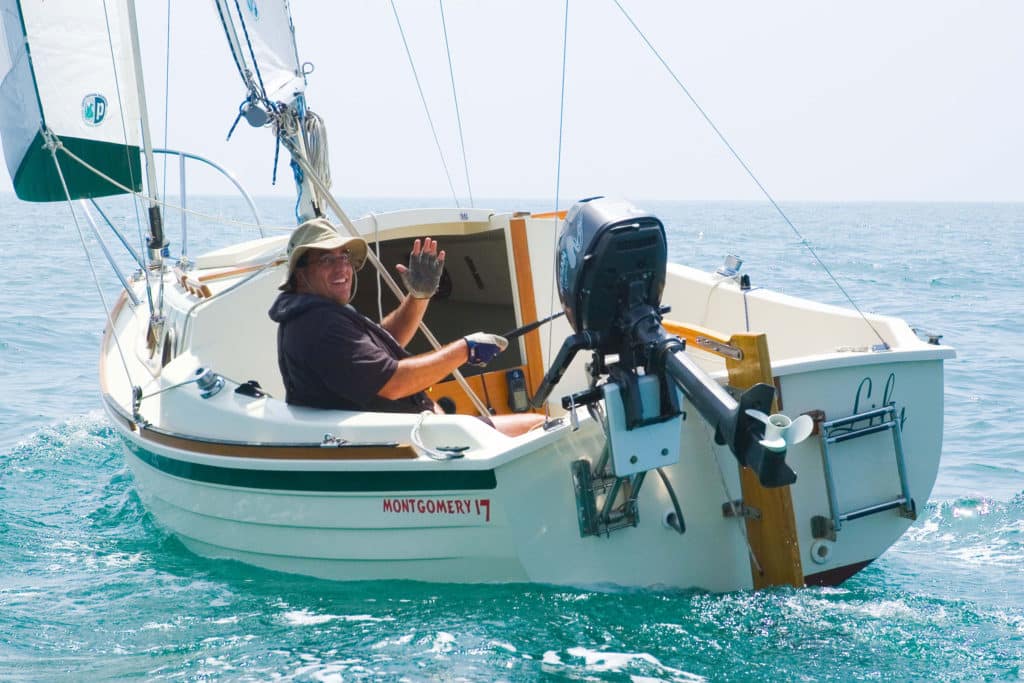
Billed as a trailerable pocket cruiser, the Montgomery 17 is a stout-looking sloop designed by Lyle Hess and built out of fiberglass in Ontario, California, by Montgomery Boats. With a keel and centerboard, the boat draws just under 2 feet with the board up and can be easily beached when you’re gunkholing. In the cuddy cabin you’ll find sitting headroom, a pair of bunks, a portable toilet, optional shore and DC power, and an impressive amount of storage space. The deck-stepped mast can be easily raised using a four-part tackle. The builder reports taking his own boat on trips across the Golfo de California and on visits to California’s coastal islands. Montgomery makes 15-foot and 23-foot models, as well. If you’re in search of a small sailboat with a cabin, the Montgomery 17 has to be on your wish list.
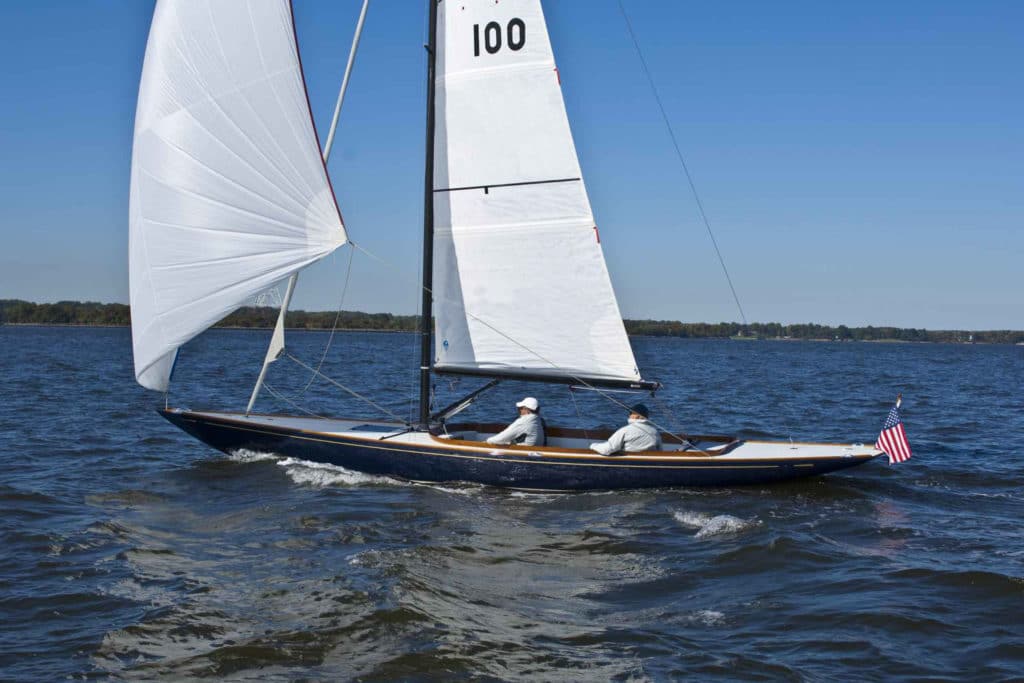
With long overhangs and shiny brightwork, the CW Hood 32 is on the larger end of the daysailer spectrum. Designers Chris Hood and Ben Stoddard made a conscious decision to forego a cabin and head in favor of an open cockpit big enough to bring 4 or 5 friends or family out for an afternoon on the water. The CW Hood 32 is sleek and graceful through the water and quick enough to do some racing, but keeps things simple with a self-tacking jib and controls that can be lead back to a single-handed skipper. A top-furling asymmetrical, electric sail drive and Torqeedo outboard are all optional. The CW Hood 32 makes for a great small family sailboat. cwhoodyachts.com
Sun Cat from Com-Pac
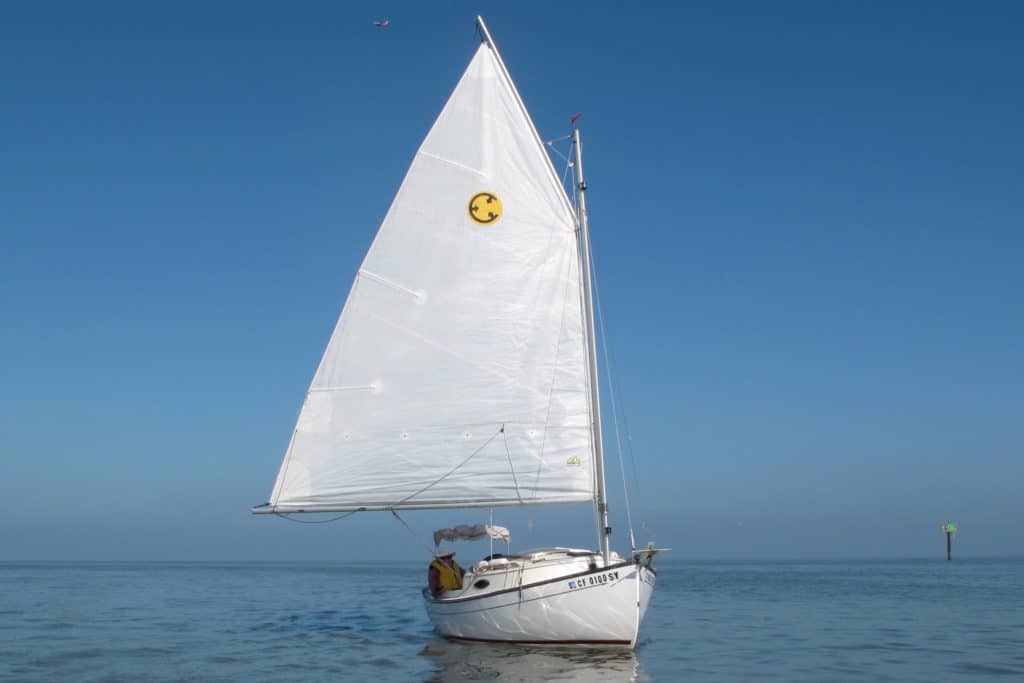
Shallow U.S. East Coast bays and rock-strewn coasts have long been graced by cat boats, whose large, gaff-rigged mainsails proved simple and powerful both on the wind and, better yet, when reaching and running. The 17-foot-4-inch Sun Cat, built by Com-Pac Yachts, updates the classic wooden cat with its fiberglass hull and deck and the easy-to-step Mastender Rigging System, which incorporates a hinged tabernacle to make stepping the mast a one-person job. If you want a personal sailboat ideal for solo sailing, the Sun Can is a great choice. Belowdecks, the twin 6-foot-5-inch berths and many other features and amenities make this cat a willing weekender.
$19,800, (727) 443-4408, com-pacyachts.com
Catalina 16.5
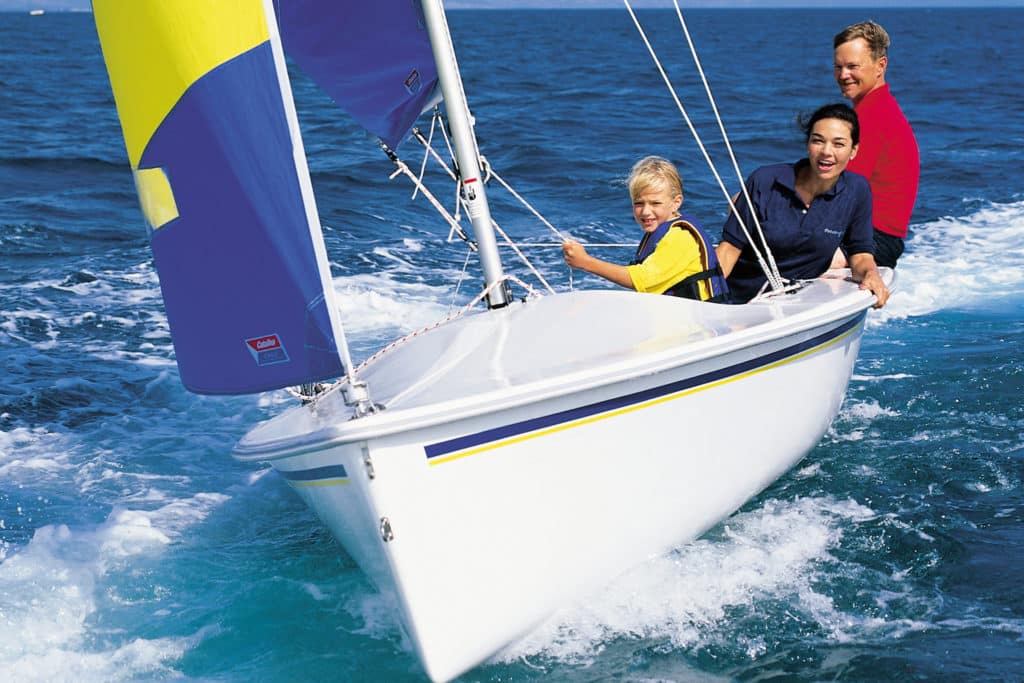
The Catalina 16.5 sits right in the middle of Catalina Yachts’ line of small sailboats, which range from the 12.5 to the 22 Capri and Sport, and it comes in both an easy-to-trailer centerboard model and a shoal-draft fixed-keel configuration. With the fiberglass board up, the 17-foot-2-inch boat draws just 5 inches of water; with the board down, the 4-foot-5-inch draft suggests good windward performance. Hull and deck are hand-laminated fiberglass. The roomy cockpit is self-bailing, and the bow harbors a good-sized storage area with a waterproof hatch. catalinayachts.com
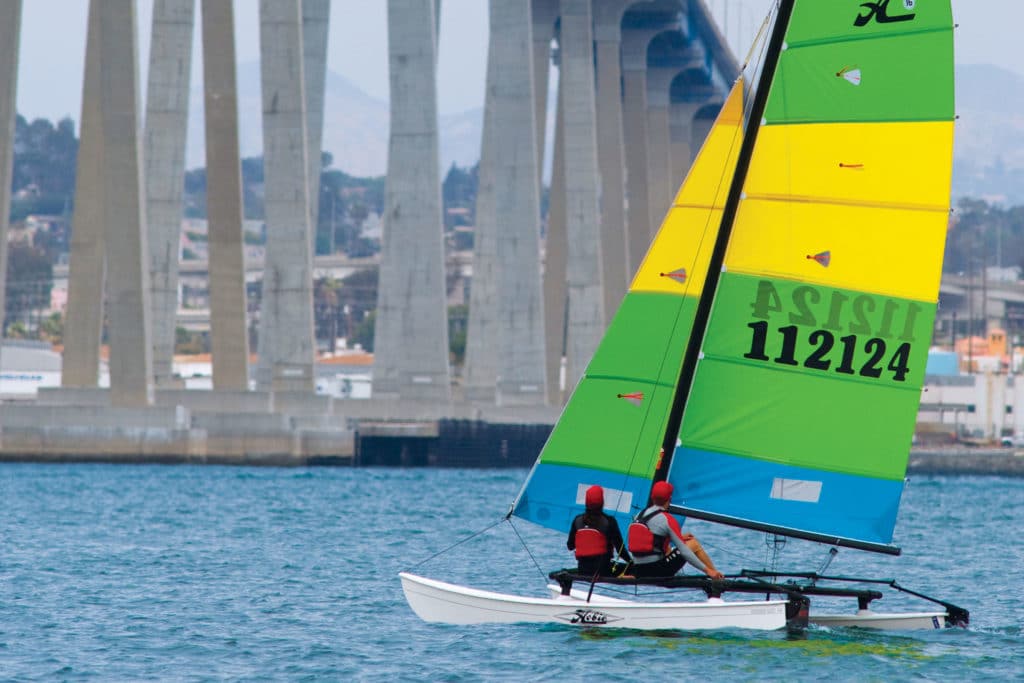
No roundup of best small sailboats (trailerable and fun too) would be complete without a mention of the venerable Hobie 16, which made its debut in Southern California way back in 1969. The company has introduced many other multihulls since, but more than 100,000 of the 16s have been launched, a remarkable figure. The Hobie’s asymmetric fiberglass-and-foam hulls eliminate the need for daggerboards, and with its kick-up rudders, the 16 can be sailed right up to the beach. Its large trampoline offers lots of space to move about or a good place to plant one’s feet when hanging off the double trapezes with a hull flying. The boat comes with a main and a jib; a spinnaker, douse kit, trailer, and beach dolly are optional features. hobiecat.com
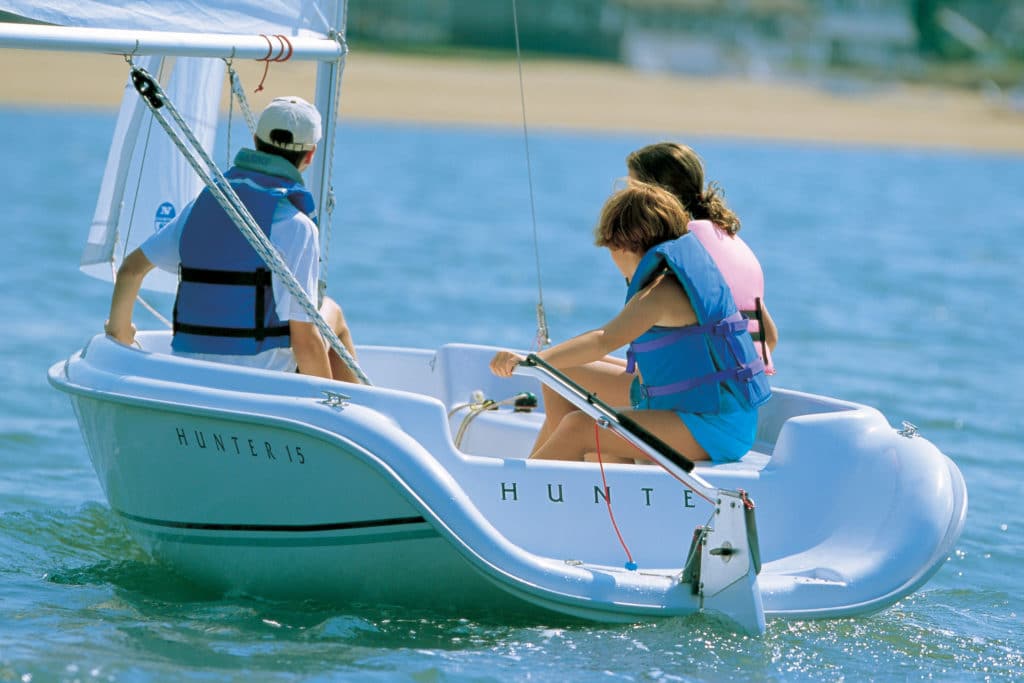
Novice sailors or old salts looking for simplicity could both enjoy sailing the Hunter 15. With a fiberglass hull and deck and foam flotation, the boat is sturdily built. The ample freeboard and wide beam provide stability under way, and the heavy-duty rubrail and kick-up rudder mean that you won’t have to worry when the dock looms or the going grows shallow. Both the 15 and its slightly larger 18-foot sibling come standard with roller-furling jibs.
$6,900/$9,500 (boat-show prices for the 15 and 18 includes trailers), (386) 462-3077, marlow-hunter.com
Super Snark
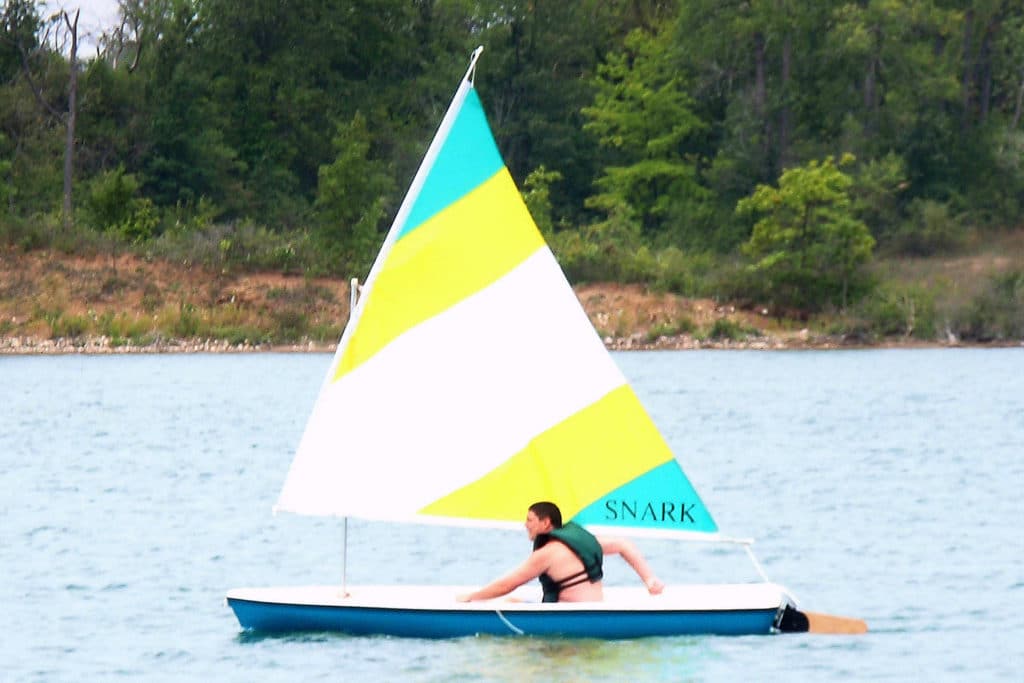
Under various owners, the Snark brand of sailboats, now built by Meyers Boat Co., has been around since the early 1970s. The Super Snark, at 11 feet, is a simple, easily car-topped daysailer that’s fit out with a lateen rig and sail. Billed as unsinkable, the five boats in the company’s line are built with E.P.S. foam, with the external hull and deck vacuum-formed to the core using an A.B.S. polymer. The Super Snark weighs in at 50 pounds, and with a payload capacity of 310 pounds, the boat can carry two.
$970, (800) 247-6275, meyersboat.com
Norseboat 21.5
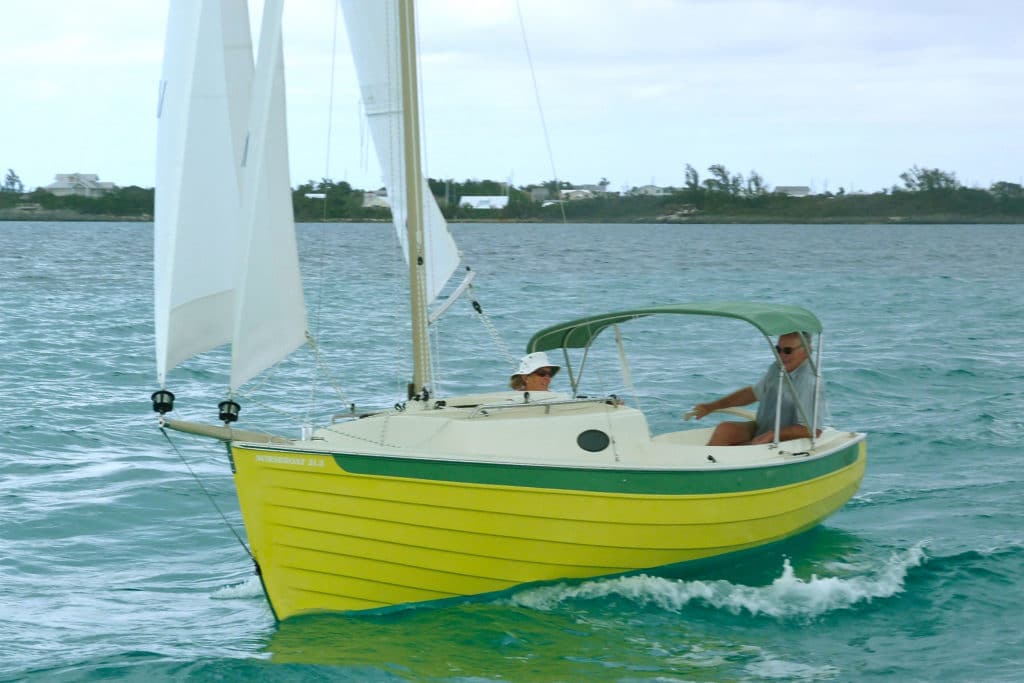
Built in Canada, the NorseBoat 21.5 is a rugged looking craft that comes in a couple of configurations: one with an open cockpit and small doghouse, and another with a smaller cockpit and cabin that houses a double berth for two adults and optional quarter berths for the kids. Both carry NorseBoat’s distinctive looking carbon fiber gaff-rigged mast with main and jib (a sprit-set drifter is optional), and come with a ballasted stub keel and centerboard. Because of its lightweight design, the boat can be rowed and is easily trailered.
$36,000 (starting), 902-659-2790, norseboat.com
Flying Scot
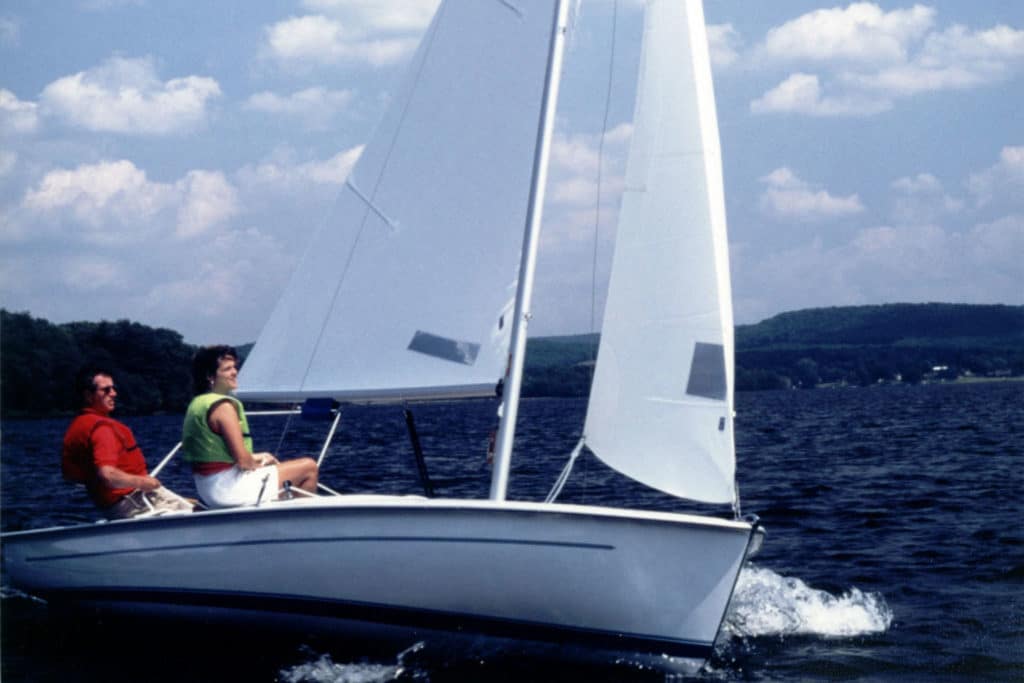
Talk about time-tested, the 19-foot Flying Scot has been in production since 1957 and remains a popular design today. Sloop rigged, with a conventional spinnaker for downwind work, the boat is an easily sailed family boat as well as a competitive racer, with over 130 racing fleets across the U.S. Its roomy cockpit can seat six to eight, though the boat is often sailed by a pair or solo. Hull and deck are a fiberglass and balsa core sandwich. With the centerboard up, the boat draws only eight inches. Though intended to be a daysailer, owners have rigged boom tents and berths for overnight trips, and one adventurous Scot sailor cruised his along inland waterways from Philadelphia to New Orleans.
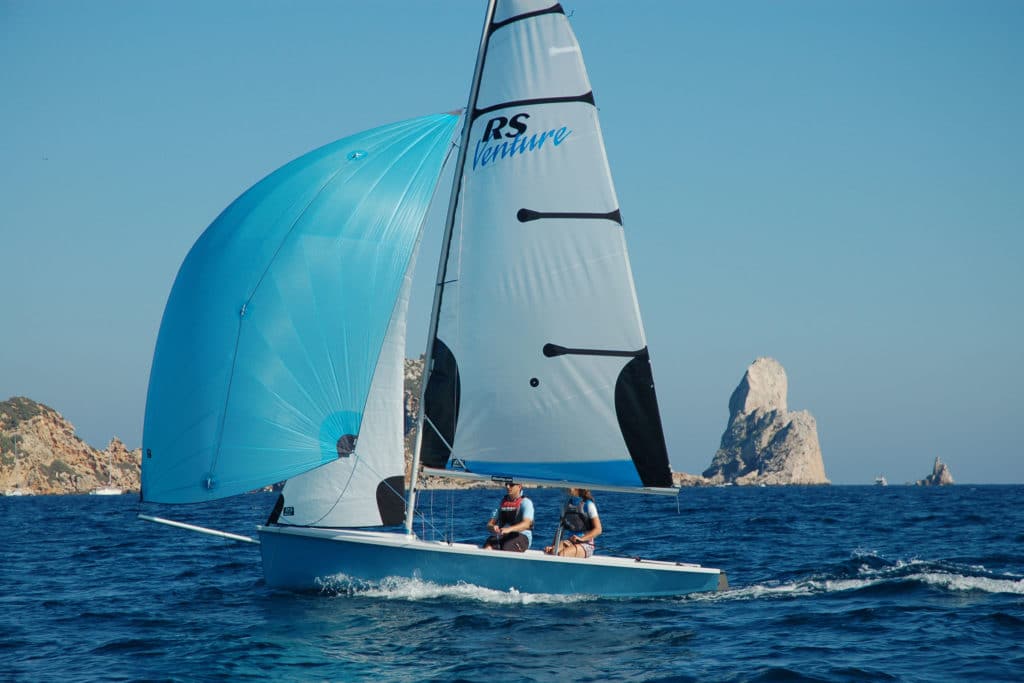
Known primarily for its line of racing dinghys, RS Sailing also builds the 16-foot, 4-inch Venture, which it describes as a cruising and training dinghy. The Venture features a large, self-draining cockpit that will accommodate a family or pack of kids. A furling jib and mainsail with slab reefing come standard with the boat; a gennaker and trapeze kit are options, as is an outboard motor mount and transom swim ladder. The deck and hull are laid up in a fiberglass and Coremat sandwich. The Venture’s designed to be both a good performer under sail, but also stable, making it a good boat for those learning the sport.
$14,900, 203-259-7808, rssailing.com
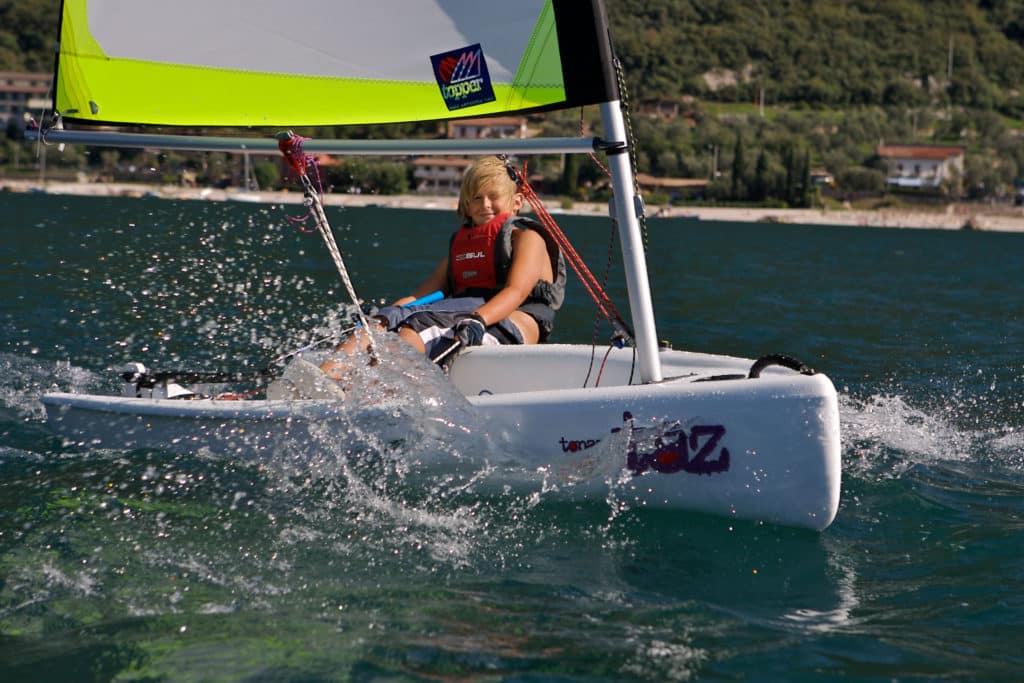
Topper makes a range of mono- and multihull rotomolded boats, but the model that caught one editor’s eye at Strictly Sail Chicago was the Topaz Taz. At 9 feet, 8 inches LOA and weighing in at 88 pounds, the Taz is not going to take the whole crowd out for the day. But, with the optional mainsail and jib package (main alone is for a single child), the Taz can carry two or three kids or an adult and one child, and would make a fun escape pod when tied behind the big boat and towed to some scenic harbor. The hull features Topper’s Trilam construction, a plastic and foam sandwich that creates a boat that’s stiff, light, and durable, and shouldn’t mind being dragged up on the beach when it’s time for a break.
$2,900 (includes main and jib), 410-286-1960, topazsailboats.com
WindRider WRTango
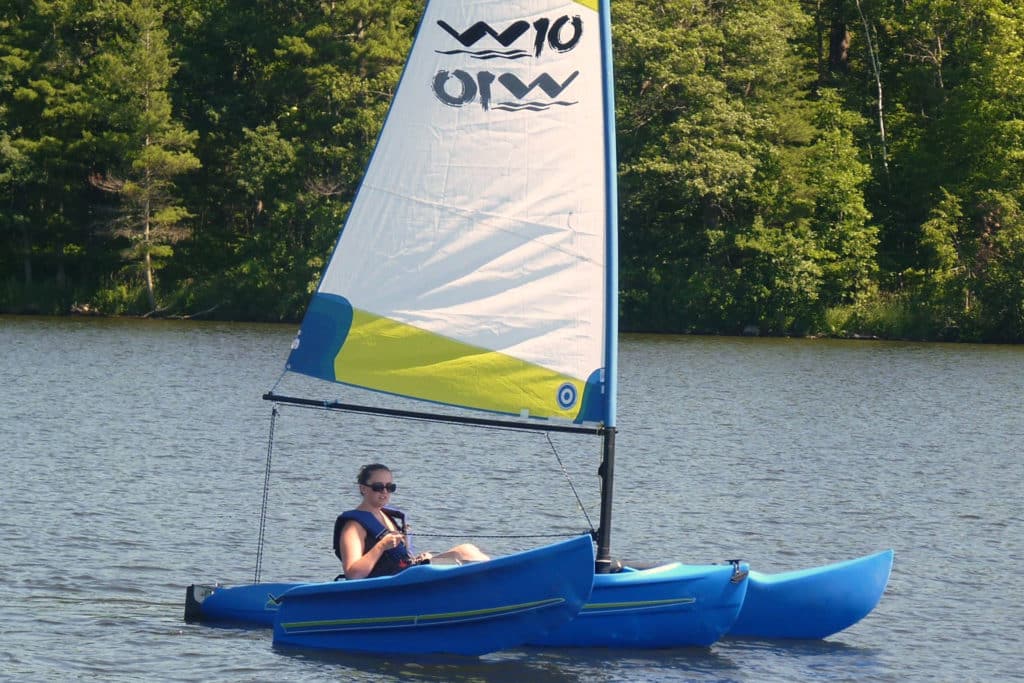
WRTango, a fast, sturdy, 10-foot trimaran that’s easy to sail, is the newest portable craft from WindRider International. It joins a line that includes the WR16 and WR17 trimarans. The Tango features forward-facing seating, foot-pedal steering, and a low center of gravity that mimics the sensation of sitting in a kayak. It weighs 125 pounds (including the outriggers and carbon-fiber mast), is extremely stable, and has single-sheet sail control. The six-inch draft and kick-up rudder make it great for beaching, while the hull and outriggers are made of rotomolded polyethylene, so it can withstand running into docks and being dragged over rocks.
$3,000, 612-338-2170, windrider.com
- More: 21 - 30 ft , Boat Gallery , day sailing , dinghy , Sailboat Reviews , Sailboats , under 20 ft
- More Sailboats
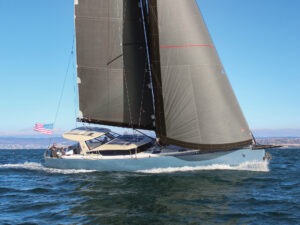
New to the Fleet: Pegasus Yachts 50

Balance 442 “Lasai” Set to Debut

Sailboat Review: Tartan 455

Meet the Bali 5.8
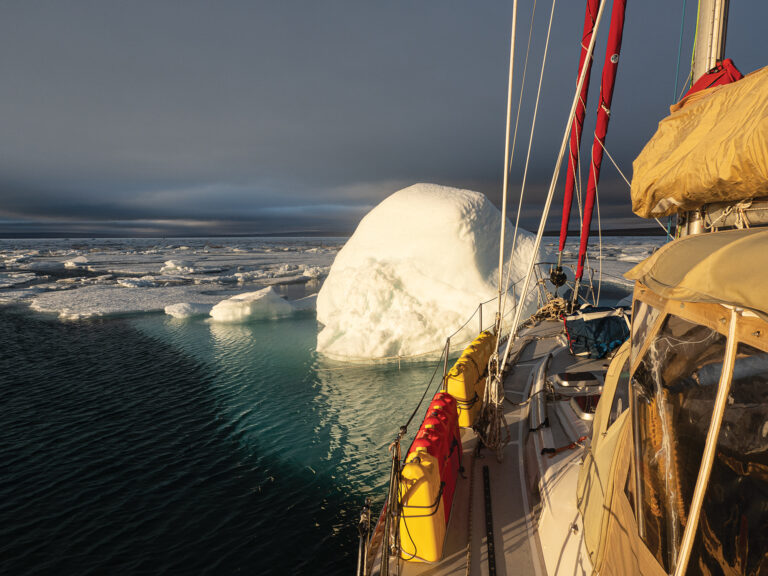
Cruising the Northwest Passage

A Legendary Sail

10 Best Sailing Movies of All Time
- Digital Edition
- Customer Service
- Privacy Policy
- Email Newsletters
- Cruising World
- Sailing World
- Salt Water Sportsman
- Sport Fishing
- Wakeboarding

Biggest Trailerable Sailboats

Last Updated by
Daniel Wade
June 15, 2022
Many sailboats up to about 27 feet in length can be trailered safely on American roads. These vessels are limited by weight, beam, and overall height.
In this article, we'll go over ten of the best large trailerable sailboats on the market. These vessels feature comfortable cabins, excellent sailing characteristics, and they all meet the requirements for towing on U.S. highways.
The best and largest trailerable sailboats are the Cal 20, the Catalina 22, the O'Day 240, The Islander 24, the Moore 24, the Cal 25, the Helms 25, the MacGregor 26, and the Nor'Sea 27. Most of these vessels can be towed behind a well-equipped truck or SUV.
We sourced information and vessel specifications for this article from sailboat manufacturers and record books. We also considered the opinions of sailors who own these vessels and sail them regularly.
Table of contents
What Makes a Sailboat Trailerable?
Trailerable sailboats must meet certain requirements in order to operate on American roads. The primary limitations are width (beam), as the vessel and its trailer must fit in regular traffic lanes and through tunnels. Another consideration is weight, as the vessel should be light enough to be towed by a 3/4 ton or 1-ton pickup truck.
Generally speaking, there's not a specific limit to boat weight in order to be towed. That said, most single and tandem-axle trailers can't exceed about 3,300 pounds per axle. With that in mind, the upper limit for a trailerable sailboat is around 7,000 to 8,000 pounds.
Keel type is an important factor to consider, as it determines how high off the ground the boat has to ride on the trailer. The majority of trailerable sailboats have a centerboard or swing keel that retracts for towing and beaching. Some vessels have shorter displacement keels or fin keels.
The maximum allowable for a trailerable sailboat is 8 ft 6 in. This is because these dimensions are the maximum limit for standard trailers on American roads. A larger boat can be transported on the road, but only as an oversize load.
In practice, very few trailerable sailboats have a beam of exactly 8 ft 6 in. The majority of large trailerable sailboats have a beam of between 7 1/2 ft and 8 ft 3 in. This makes it easier to negotiate tunnels and tighter traffic lanes.
Overall Length
The maximum trailer length for standard trailers is 65 ft, but it's nearly impossible for a trailerable sailboat of this length to meet the width requirements. In practice, the longest trailerable sailboats are around 30 ft in length or shorter. The average is about 20 to 25 ft.
In most states, the maximum height for a trailer load is 14 ft. This necessitates that the mast folds down and that the keel and vessel height combined doesn't exceed 14 ft. You must also take into account the height of the trailer, as a tall boat may not be able to clear highway overpasses.
10 Largest Trailerable Sailboats
Trailerable sailboats come in all shapes and sizes, including some large and roomy configurations. The vessels we chose range in length from 19 ft to 27 ft, and they offer the best accommodations on the market. Here are ten of the best large trailerable sailboats.
1. West Wight Potter 19
It's impossible to write an article about trailerable sailboats without mentioning the West Wight Potter 19. This vessel is perhaps the best and most capable in its class, and it offers surprisingly comfortable accommodations for a lightweight trailerable sailboat.
The West Wight Potter 19 is easy to sail fast and features a roomy cabin with a sink and space for a head. It's considered a pocket Cruiser, and it is very popular in coastal areas. Due to its lightweight construction, this fiberglass sailboat is trailerable behind an SUV or half-ton pickup.
The West Wight Potter 19 has positive buoyancy material throughout the whole, making it effectively unsinkable. Additionally, the mast and rigging collapse and set up in minutes. These vessels were produced up until recently, so they're common on the used market.
- Lightweight
- Rigs up fast
- Roomy cabin
- Relatively slow
The Cal 20 has been around for decades, and this capable racing boat is ideal the coastal cruising and sailing in semi-protected waters. That said, it's also quite seaworthy, as several have participated in TransPac races between San Francisco and Hawaii.
The Cal 20 is known for its low-profile cabin and easy trailering. At 20 ft in length overall, the Cal 20 is well within limits for trailering on American roads. While not the lightest trailerable sailboat on the list, a well-equipped pickup truck should tow it without issues.
The Cal 20 isn't the boat to choose if you're looking for the most spacious accommodations. That said, the cabin is functional, and the boat excels in handling. It's fast, safe, and agile, thanks to its long and thin profile. It's also a joy to sail in all kinds of weather conditions.
- Easy to sail
- Stable in high winds
- Spartan cabin
- Deep draft from the fixed keel
3. Catalina 22
The Catalina 22 is one of the most famous large trailerable sailboats ever built. It's one of Catalina's most popular models, and it was a big hit in the 1970s and 1980s. The Catalina 22 has a spacious and thoughtfully designed cabin with a wide companionway and a comfortable V-berth.
The Catalina 22 is a centerboard boat. This means that the keel retracts into the hull for trailering and lowers down easily using a system block-and-tackle or a crank. The vessel is 7.67 feet wide, making it easy to tow on typical American highways.
The vessel is still produced today, and over 15,000 have been built since 1969. This makes it one of the most popular sailboats ever, and hundreds are available on the used market for reasonable prices. Thanks to its superior handling and excellent design, the Catalina 22 is one of the best large trailerable sailboats available.
- Well-designed cabin
- Affordable iconic sailboat
- Minimal headroom
- Finicky companionway hatch
4. O'Day 240
The O'Day 240 is one of the more seagoing trailerable sailboats on our list. It's beamy and stable, and it handles well in rougher weather conditions. It has a surprisingly comfortable cabin for its size and measures just 24 feet in length overall.
The vessel's wide beam contributes to its stability. However, with a width of 8 ft 3 in, the O'Day 240 approaches the upper limit of trailerable dimensions. The vessel weighs more than comparably sized boats, so you'll need a more powerful vehicle to tow it.
The cabin of the O'Day 240 stands out. It features a V-berth, berthing aft, a galley, and space for a head. There's ample headroom throughout the cabin, which makes the O'Day 240 ideal for extended coastal cruising.
- Stable Spacious cabin
- May be too wide for comfortable trailering
- Unusual cabin design
5. Islander 24
Islander is known for its larger sailboats (28 feet and larger), though it has produced a few excellent trailerable models. We chose the trailerable Islander 24, as it's known in the sailing community for its speed, comfort, and easy handling.
The phrase "they don't build them like they used to" applies to the Islander 24. When this vessel was designed in the early 1960s, boat manufacturers used more fiberglass and produced thicker hulls. This practice is costlier and made the boat weigh more. But it produced stronger vessels that last much longer than their flimsier contemporaries.
This fiberglass sailboat is thoughtfully designed and is well-suited for coastal cruising in the 21st century. It features stronger construction than similar models, and its keel design encourages stable and comfortable sailing.
- Strong hull and deck
- Stiff sailing
- Great windward performance
- Small cabin
- Heavy trailer weight
6. Moore 24
The Moore 24 was the first in a new class of vessels called the ultralight displacement sailboat. It has the handling characteristics have a large keelboat but the dimensions of a coastal cruising trailer-sailer.
From the outside, the flush deck of the Moore 24 looks like it couldn't possibly accommodate a cabin. Closer inspection reveals that the vessel has a roomy cabin that resembles that of much larger boats. It features a galley, a head, a V-berth upfront, and attractive paneling throughout.
The Moore 24 is a pocket cruiser by all definitions. It's
an excellent choice for those looking for a trailerable and seaworthy sailboat. Though a bit taller than some other models, the vessel is still well within limits for on-road transportation.
- Excellent handling
- Large cabin
- Heavier than many other 24-foot sailboats
The Cal 25 is essentially a stretched version of the Cal 20. It features the same basic hull design with the iconic flush deck and streamlined cabin. However, it's faster, offers superior accommodations, and it's more seaworthy.
The Cal 25 is known for its stiff handling characteristics in high winds. This is primarily due to its 1,700-pound lead keel, which keeps it upright and tracking straight. However, this does increase the overall weight of the vessel, which is an even 4,000 pounds dry. Thankfully, this is within the towing capacity of most standard pickup trucks.
The interior of the Cal 25 resembles the cabins of larger boats. In other words, it doesn't feel cramped. There's a large sitting area across from the galley and partitions separating the V-berth from the rest of the cabin. Overall, the Cal 25 is an excellent compact sailboat for racing or cruising.
- Good accommodations
- Marginal headroom in some areas

8. Helms 25
The Helms 25 is a compact vessel with a true swing keel. Unlike a centerboard, which descends through the hull straight down, a swing keel swings down on the hinge and occupies less space inside of the vessel. With the removal of the centerboard trunk, the Helms 25 retains its trailerable properties while freeing up living space in the cabin.
The Helms 25 is long and fast but not particularly tall. It fits well on a trailer, and its rounded hull doesn't pound in choppy water. The cabin is comfortable and features a small but usable galley, a table with two seating areas, a V-berth, and additional berthing aft.
Some versions of the Helms 25 also feature a separate head area between the V-berth and the central living spaces. The Helms 25 strikes the perfect balance between comfort, seaworthiness, and trailerability. It's safe and fun to sail and sells on the used market for affordable prices.
- Spacious cabin
- Long, narrow, and shallow
- Not ideal for offshore sailing
- Too long for some trailers
9. MacGregor 26
The MacGregor 26 is larger and more modern than most of the sailboats on our list. As a result, it takes advantage of recent design developments that make it an excellent large trailer-sailer. At 26 ft overall, the MacGregor 26 is also one of the fastest vessels on our list.
At first glance, the dimensions of the MacGregor 26 seem unusual. The hull shape resembles a bathtub, and the vessel's high profile is notable. These characteristics make it stable and easy to handle, and they also give it exceptional headroom in the cabin.
The McGregor 26 came in numerous configurations, which are designated with letters such as '26D' and '26M.' These include various cabin window orientations, colors, accessories, and interior layouts. Some versions of the MacGregor 26 came with a dual rudder setup, which is uncommon in its size range.
- Modern design
- Excellent headroom
- Unusual shape
10. Nor'Sea 27
The final trailerable sailboat on our list is also the most capable. The Nor'Sea 27 is a true offshore sailboat with accommodations that rival any mid-size cruising sailboat. the Nor'Sea 27 is a full-keel displacement sailboat that's designed for stability and motion comfort. It's one of the beefiest sailboats that still fits on a trailer.
The Nor'Sea 27 features standing headroom throughout the cabin. It has a head, galley, and berthing area forward that converts into a table. The cabin is lined with attractive wood paneling, and the entire vessel has a very high level of fit and finish.
The Nor'Sea 27 is built for cruising, and it's ideal for longer voyages and offshore passages. If you're looking for a true cruising sailboat that stores well on a trailer, you can't go wrong with the NorSea 27. Due to its size and capabilities, you'll need a larger vehicle to trailer this vessel safely.
- Biggest cabin
- Full-size accommodations
- Offshore capable
- Too large for SUV towing
- Slow to rig and disassemble

Related Articles
I've personally had thousands of questions about sailing and sailboats over the years. As I learn and experience sailing, and the community, I share the answers that work and make sense to me, here on Life of Sailing.
by this author
Best Sailboats
Most Recent

What Does "Sailing By The Lee" Mean?
October 3, 2023

The Best Sailing Schools And Programs: Reviews & Ratings
September 26, 2023
Important Legal Info
Lifeofsailing.com is a participant in the Amazon Services LLC Associates Program, an affiliate advertising program designed to provide a means for sites to earn advertising fees by advertising and linking to Amazon. This site also participates in other affiliate programs and is compensated for referring traffic and business to these companies.
Similar Posts

Affordable Sailboats You Can Build at Home
September 13, 2023

Best Small Sailboats With Standing Headroom
December 28, 2023

Best Bluewater Sailboats Under $50K
Popular posts.

Best Liveaboard Catamaran Sailboats

Can a Novice Sail Around the World?
Elizabeth O'Malley

4 Best Electric Outboard Motors

How Long Did It Take The Vikings To Sail To England?

10 Best Sailboat Brands (And Why)
December 20, 2023

7 Best Places To Liveaboard A Sailboat
Get the best sailing content.
Top Rated Posts
Lifeofsailing.com is a participant in the Amazon Services LLC Associates Program, an affiliate advertising program designed to provide a means for sites to earn advertising fees by advertising and linking to Amazon. This site also participates in other affiliate programs and is compensated for referring traffic and business to these companies. (866) 342-SAIL
© 2024 Life of Sailing Email: [email protected] Address: 11816 Inwood Rd #3024 Dallas, TX 75244 Disclaimer Privacy Policy
Browse by Category
- Coach of the Year
- High School Sailing Team of the Year
- Optimist Sailor of the Year
- Sailing Fitness
- Regatta News/Results
- Boat Speed/Tuning/Sailtrim Articles
- General Sailing News
- Coaches Locker Room
- From the Experts
- Profiles in Pro Sailing
- Featured Jobs
- Marketplace Ads
- Skip to primary navigation
- Skip to main content
- Skip to primary sidebar
- Skip to footer
Sail1Design
First Name*
Email Address*
November 30, 1999 by Sail1Design Editor Leave a Comment
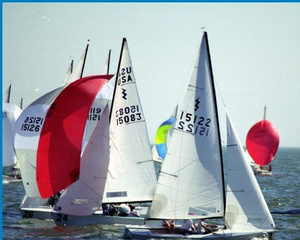
Without Compromising Either One The Lightning, a 19 foot trailerable centerboard sloop, was originally designed by Sparkman & Stephens as an affordable family day-sailor and racing boat. She has evolved into one of the most popular and competitive one-design racing classes in the world. Awarded ISAF International Class status, the Lightning is sailed in more than 13 countries and in the Pan American Games, and the class provides a professionally-managed association that is among the largest in all of one-design sailing. The Lightning’s rig is simple, but offers sophisticated sail shape controls. The hull features a unique hard chine design that combines the stability that provides sail-carrying power, with flat bottom sections that promote planing. The International Lightning Class Association protects the boat’s design and licenses custom and private builders to build boats under its administration. A list of Lightning builders is available from the ILCA upon request.
Dinghy Responsiveness, Sportboat Performance
The Best Of Both Worlds Whether racing or daysailing, the Lightning offers a combination of performance and stability that eludes most one-designs. The Lightning’s hard chine and 130 lb centerboard give her the stability and power of a small keel boat going to weather in strong winds and allow her to carry a very large spinnaker for breathtaking offwind rides. There’s room in the cockpit for two couples or a family to daysail, but the Lightning is easy to ramp launch and light enough to trailer with ease. In the event of a capsize, she can be righted and sailed dry by her crew.
Refined Design, Toda
The Best Of Both Worlds Whether you’re more interested in how a boat looks or how it behaves, it’s hard to beat the Lightning. The Class maintains an attitude that promotes conservative innovation, making the boat faster, safer and more maintenance free, while keeping prices affordable. Most Lightnings built in the last 25 years can be made competitive and it’s not uncommon to see them winning races right along with new ones. In fact the 1995 World Champion sailed a boat built in 1969! Modern Lightnings are built in foam-cored fiberglass with stainless steel centerboards and black anodized aluminum spars. The world’s top sailmakers give the class their best efforts. In short, there are enough controls to keep the most technically inclined happy, but it’s good tactics, boat-handling and hiking that win races.
The Best Competition In The World Or A Way To Get Away From It
The Best Of Both Worlds
Ted Turner, Dennis Conner, Ken Read, Dave Dellenbaugh, Dave Curtis, Bruce Goldsmith, Tom Allen, Neal Fowler, Steve Benjamin, Ched Proctor, Bill Shore, Greg Fisher, Andy Horton are just a few of the rock stars who have competed in the Lightning. After more than 60 years and more than 15,000 boats it’s easy to find a regatta when you want to. But whether you’re interested in serious racing or you just want to go for a joyride with the family, you’ll find what you’re looking for in the Lightning. Club Racer Or International Icon
The Lightning truly excels as a racing boat. It requires a wide range of different skills, both tactical and technical. At 700 pounds all up, the boat is tough enough to avoid frequent breakdowns, but light enough to plane wildly on the reaches. A World Championship is held every two years. North American, South American and European Championships are held each year as are innumerable regional and District championships. Major regattas attract some of the finest sailors in the world, but you find class members friendly and the sailmakers’ complete tuning guides helpful at getting you up to speed in a hurry.
The International Lightning Class Association
Welcome To Our World
The ILCA is one of the oldest and best organized class associations in sailboat racing. Its primary purpose is to serve its membership, preserve the integrity of the Lightning and provide high-quality competitive events. In addition, the ILCA publishes a monthly newsletter Lightning Flashes with up-to-date regatta news, boat brokerage and ideas on how to get the most out of your Lightning. An annual Yearbook, containing many illustrated articles, reports on major championships, fleet reports and a complete association mailing list, is also published. The professional ILCA staff is always on hand to assist both current and potential members. If you’re looking for a boat you can be proud to sail, one that offers dinghy handling with the performance of a sportboat, a refined design that’s free of fads, complete with the technology of today for both racing and daysailing
Get The Best Of Both Worlds. Get into a Lightning. See you on the water. David Dellenbaugh, former Lightning World Champion and starting helmsman for 1992
America’s Cup defender America3
The Top 10 Things I Like About The Lightning: 1. There’s Lightning racing almost everywhere. 2. Some of the best sailors in the world sail the Lightning. 3. Lightnings are available from more than one high-quality builder. 4. Lightnings even 20 years old are still competitive. 5. The boat is one of the best crew trainers on the water today. 6. The class is not so strict as to discourage experimentation which makes the boat faster and easier to sail. 7. The Lightning has interested the finest sailmakers in the world so the sails and the tuning guides look great and are easy to use. 8. The Lightning is a very roomy boat for daysailing. 9. Lightning sailors sail hard, but they’re not too cutthroat – someone’s always ready to answer questions. 10. The class management is as good as you’ll find in one-design sailing. For more information about the International Lightning or to arrange a test sail in your area, call or write to the address listed below.
Design: Sparkman & Stephens, 1938 Over 15000 built More than 500 fleets worldwide Length: 19’0″ (5.8m) Beam: 6’6″ (2m) Displacement: 700 lb (318 kg) Draft (board down): 4’11” (151.3cm) (board up): 5″ (12.8cm) Mast height: 26’2″ (7.9m) Sail area (main & jib): 177 sq.ft. (spinnaker): 300 sq.ft. Crew (racing): 3
Class website: http://www.lightningclass.org/index.asp
Reader Interactions
Leave a reply cancel reply.
Your email address will not be published. Required fields are marked *
By submitting this form, you accept the Mollom privacy policy .

One Design Classes
Browse the airwaves.
- Sailing News Articles
- High School & College News Articles
- One-Design Class Profiles
- Tactics & Strategy
- Sailing & Education
- ICSA Rankings
- Sailing/Yacht Club Profiles
- Youth Sailor of the Year
- Sail1Design Annual Awards
Helpful Links
- Join the S1D Team
- Accessibility Help
- Privacy Policy
- Entries feed
- Comments feed
- WordPress.org
- New Sailboats
- Sailboats 21-30ft
- Sailboats 31-35ft
- Sailboats 36-40ft
- Sailboats Over 40ft
- Sailboats Under 21feet
- used_sailboats
- Apps and Computer Programs
- Communications
- Fishfinders
- Handheld Electronics
- Plotters MFDS Rradar
- Wind, Speed & Depth Instruments
- Anchoring Mooring
- Running Rigging
- Sails Canvas
- Standing Rigging
- Diesel Engines
- Off Grid Energy
- Cleaning Waxing
- DIY Projects
- Repair, Tools & Materials
- Spare Parts
- Tools & Gadgets
- Cabin Comfort
- Ventilation
- Footwear Apparel
- Foul Weather Gear
- Mailport & PS Advisor
- Inside Practical Sailor Blog
- Activate My Web Access
- Reset Password
- Customer Service

- Free Newsletter

Ericson 34-2 Finds Sweet Spot

How to Sell Your Boat

Cal 2-46: A Venerable Lapworth Design Brought Up to Date

Rhumb Lines: Show Highlights from Annapolis

Leaping Into Lithium

The Importance of Sea State in Weather Planning

Do-it-yourself Electrical System Survey and Inspection

Install a Standalone Sounder Without Drilling

When Should We Retire Dyneema Stays and Running Rigging?

Rethinking MOB Prevention

Top-notch Wind Indicators

The Everlasting Multihull Trampoline

Check Your Shorepower System for Hidden Dangers

DIY survey of boat solar and wind turbine systems

What’s Involved in Setting Up a Lithium Battery System?

The Scraper-only Approach to Bottom Paint Removal

Can You Recoat Dyneema?

Gonytia Hot Knife Proves its Mettle

How to Handle the Head

The Day Sailor’s First-Aid Kit

Choosing and Securing Seat Cushions

Cockpit Drains on Race Boats

Re-sealing the Seams on Waterproof Fabrics

Safer Sailing: Add Leg Loops to Your Harness

Waxing and Polishing Your Boat

Reducing Engine Room Noise

Tricks and Tips to Forming Do-it-yourself Rigging Terminals

Marine Toilet Maintenance Tips

Learning to Live with Plastic Boat Bits
- Sailboat Reviews
New J/95 Centerboard Sailboat is Fit for Shallow Water
J/boats new shoalsailer redraws the playing field for fast daysailers..
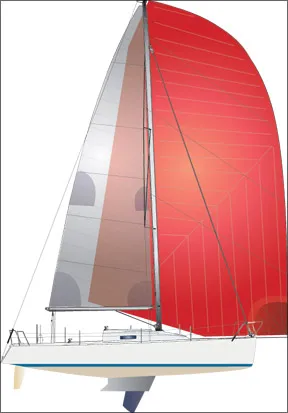
Given the grief that poor centerboard designs from the 1970s have caused sailers over the years, we were surprised to learn that J/Boats-known for its measured approach to the boat business (don’t let that radical backslash fool you)-put a centerboard in its new J/95.
Yes, swing-keel centerboards, those bronze, steel, or fiberglass foils that hinge from the keel like the blade on a Swiss army knife, are making a comeback. This is great news for shoalwater sailers who, for lack of other options, have tolerated decades-old centerboarders and the many ailments that plague them-corroded lifting cables, pulverized turning sheaves, and a thunk, thunk, thunk in the centerboard trunk. Fortunately for them, advances in materials and design have yielded a whole new breed of centerboarder. The J/95, it is safe to say, is not your fathers Irwin 38.
The last time centerboards were all the rage, through the 1950s and into the 1960s, it was because Northeast sailors didnt want to leave their good crystal at home when they raced off to Bermuda. In the Cruising Club of Americas (CCA) quest for a rating rule that favored velvet and walnut interiors, centerboarders gained a significant edge, and few boats took advantage of rule loopholes as well as the legendary Sparkman & Stephens-designed Finisterre. The boat achieved myth-like status in 1960, when owner and skipper Carleton Mitchell won the Newport to Bermuda race for an unprecedented third consecutive time.
When Mitchell died in 2007 at the age of 96, he was rightly hailed as a sailing legend. A one-time underwear salesman who married into a fortune, he served as a Navy combat photographer in World War II before pursuing in earnest a lifelong passion for sailing. In the decades after the war, he earned renown not only for his seamanship but also for his talent as a magazine writer, author, and photographer. The museum at Mystic Seaport in Connecticut holds his large collection of manuscripts and more than 20,000 of his photographs.
Today, Mitchell and Finisterre stand as icons from a golden era, doomed to an eternal afterlife in new boat marketing literature. But when J/Boats alluded to Carleton Mitchell and Finisterre in brochures for the J/95, we wanted a bottle of whatever theyre putting in the company watercooler. Except for a hinged keel and an inclination to float, the two boats are as alike as Neil Simons Felix and Oscar.
Introduced last year, the balsa-core J/95 is a lightweight, 30-foot daysailer with a plumb bow, twin-rudders, a sleek hull form, and a Spartan interior. Launched in 1954, 38-foot Finisterre is a double-planked heavy displacement racer-cruiser with a spoon bow, yawl rig, and almost swanky accommodations (the last three are all convenient CCA rule-beaters).
The reference to Finisterre is smart promotional shtick. The name offers J/Boats-and it is hardly the only company that has drafted on Finisterres fame-an instant connection to the sailors it seeks to entice with the J/95.
Like Morris, Sabre, Friendship, and the other makers of high-end trophy daysailers we reviewed in the January 2009 issue, the J/95 is aimed at recession-proof sailors who share Mitchells aesthetic tastes and passion for sailing. But unlike previous entries in this market, the J/95 sails in four feet of water and offers, in many ways, a saner approach to what dealers are calling “right-sizing.” (No salesman worth his salt would utter the more accurate word, “downsizing,” to a potential buyer of these boats.)
End of an era
The J/95 is the brainchild of Rod Johnstone, a man whose fairy-tale success is well known to longtime PS readers. Back in 1976, Johnstone built a fast little boat called Ragtime in his garage in Connecticut. It promptly trounced the local racers, who started asking Johnstone for their own.
At the time, Johnstone was an ad salesman for Soundings magazine and turned to his client Everett Pearson of TPI Inc. to produce the boat as the J/24. (The J is for Johnstone, the slash, were convinced, is meant to torment copy editors.) J/24s started rolling off the production line at TPI in February 1977. Bob Johnstone, the family marketing ace, left AMF Alcort (makers of the Sunfish) to join Rod as a partner, and crank up the boat sales to unprecedented numbers. Still in production, the J/24 remains one of the most popular sailboats in the world.
The mission for the J/95 is one of those hyphen-rich, have-your-cake-and-eat-it-too quests. Rod Johnstone wanted a wind-in-your-hair, but easy-to-sail weekender that catered to the huge population of sailors who must contend with depths of four feet our less. Being competitive in club or Performance Handicap Racing Fleet (PHRF), and, of course, a fantastically popular one-design class were also part of the dream.
“We wanted to make this a boat people would want sail, sail right up the river or creek, right up to their dock, sail in light winds, sail in 20 knots,” says Johnstone. “In my view, if you want to turn on the engine, this boat is a failure.”
When held up against the current crop of J/Boats, the J/95 is probably closest to the J/105, a popular one-design class boat launched in 1992. Both boats have similar deck layouts, and both feature a low cabintop and gentle sheer that give them good-looking profiles.
Although the J/105s deeper fin keel gives it a performance edge, Johnstone says that in brisk conditions, the J/95, with 2,250 pounds of lead ballast, can stay with the J/105 in a heavy-weather beat. Johnstones explanation for this sheds some light on why many CCA-rule boats remain popular as cruisers.
While the long bulb keel that is the norm in todays racing boats offers superior lift, it can create a pendulum-like pitch and roll and in a seaway. The J/95, with the center of ballast closer to the flotation plane, resists this tendency, making for a more efficient-and more comfortable-ride.
Of course, any of the J/95s gains during a rough beat are soon relinquished to the J/105s longer waterline on a downwind leg, but the point is made.
Compared to contemporary production shoal-draft boats, the J/95 has a key design advantage: twin rudders angled outward at 15 degrees. This means at least one rudder is always immersed, giving the boat predictable tracking, even when heeled. As pointed out in our February 2009 report on hull design, trying to steer the beamy Open Class-inspired hulls with a single shallow rudder can be maddening. In the most extreme cases, a modest puff of 16 knots sends the boat rounding up sharply to windward.
The price for the J/95s shallower draft is ultimate stability. According to J/Boats, the boat has a limit of positive stability of 126, well within the minimum of 120 recommended for offshore racing and fine for daysailing. The 200-pound centerboard doesn’t lock down, but should the board kick up in a grounding or crash downward a 160-degree capsize, it will connect with the soft lead keel and cause no harm to the hull. J/Boats said such an event would not damage the hull. (With our insurance premiums being what the are, we did not test this feature.)
Deck Layout
J/Boats has had plenty of practice pondering deck layouts on race boats, and those same details translate well to any good daysailer. As Johnstone points out, the features that bring efficiency on the race course-broad sidedecks, ergonomic cockpit layout, plenty of mechanical advantage-are equally kind to a titanium knees and hips.
“It just makes me sad to see people I know-friends, no less!-going out and getting power boats because they feel that they can’t sail anymore,” Johnstone grumbles. “And then they realize, too late sometimes, that they have to put up with all that noise.”
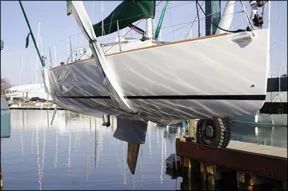
During the design phase, there was some discussion over tiller versus wheel. J/purists might clamor for a tiller, especially those bent on racing, but at what price? Cockpit space would suffer. Comfort and convenience, too.
The 44-inch Edson wheel fits nicely into the wide T-shaped aft section. Two angled chocks provide footing on a heel, and we found the windward rail to be a comfortable spot on a close reach. The transom is open, and the boat we sailed had an optional removable transom-seat locker. Even with the seat-locker in place, theres room behind the wheel.
The cockpit seats arent long enough for snoozing, and an extra inch of back support would be nice, but all in all, the cockpit caters well to crew comfort under way. The seats inside edges are angled upward slightly to anchor the tush, and the seat lockers offer ample space for sail and gear storage. The broad flat coaming is as comfortable a perch as the cockpit seats themselves. Owners can opt for either a full length toerail or one that ends forward of the cockpit. Teak is an option, but one of the appeals of the boat is its ease of maintenance.
The Harken sail controls are geared for minimal effort. The mainsheet (5:1-ratio with a 10:1-ratio fine-tuning adjustment), rides in front of the steering binnacle on an easily-trimmed traveler (4:1-ratio). A Hall Spars Quick Vang (5:1 ratio) handles boom tension.
The jibsheets lead to two 40.2STA two-speed self-tailing winches. The helmsman can easily trim the mainsheet from the windward rail, while the jib sheet winches are placed so that the trimmer can comfortably face forward. Casually seated on the coaming just in front of the wheel, the single-hander can tweak both the main and jib sheets.
The standard working jib is a roller-furling 105 that tacks easily through the foretriangle and leads to a jib track inside the shrouds. We kept the leads pinned just aft of the shrouds during the test sail and saw no need to change them. For PHRF racing, a second track is installed to handle the 150 genoa. (The boats PHRF rating is about 109.)
A Harken 32.2 two-speed self-tailing winch and a gang of three Spinlock rope clutches on the port side of the companionway tame the halyards and the centerboard. We didnt need the winch (or anti-inflammatories) to raise the centerboard, as the 5:1-ratio block and tackle gave plenty of mechanical advantage.
Passage fore and aft is wide and clear of obstructions, with stainless-steel handrails on the coachroof adding security. Eight-inch stainless steel cleats and a modest anchor locker round out the very functional deck layout.
Interior and Systems
With the J/95s emphasis on nice lines and a functional deck layout, its no surprise that the accommodations get the short shrift. Though its billed as a weekender, we call it a daysailer.
For boat camping, the layout takes care of the bare essentials. Two settee berths in the main cabin offer room to recline, but headroom, even when sitting, is tight. A Raritan head (served by a 14-gallon holding tank) shares space with a V-berth forward. A forward hatch and two ports keep the cabin aired out.
There is no nav station or galley, not even a stove, although hull No. 1 was equipped with AC shorepower and a microwave oven. A 48-quart cooler or a portable 12-volt Waeco fridge ( PS , May 2007) tucks aft of the port settee. An optional Group 27 house battery will keep the fridge running for a long day without charging.
Optional water tankage is in a 20-gallon bladder that feeds a pressure pump in the head and a cockpit shower. Fuel is in a 15-gallon tank beneath the port cockpit locker. PS generally prefers aluminum tanks for this purpose, but for a tank this small, a baffled polyethylene tank is a tolerable substitute.
The two-cylinder 14-horsepower Yanmar with a saildrive and Flex-O-Fold prop sits beneath slide-out companionway steps. Access is good except for servicing the water and primary fuel filters, when you need to make an awkward reach through a bulkhead cutout. J/Boats says it has worked closely with Yanmar to insure that the saildrive is protected from any galvanic corrosion. Regardless, engine zincs bear watching.
Now for the downers: Like some other Open Class imitators (Beneteau First 10R comes to mind), J/Boats hasn’t yet sorted out how to drain the boats shallow bilge without a sponge. The narrowest electric pump doesn’t fit into the tight squeeze in the sump. It sits on a riser pad, which means the last three inches of water make for an inviting frog pond.
To complicate matters, the hose on our test boats manual pump wheezed at a leaky hose union, rendering the pump useless. A leaky union-or any union at all-in an emergency bilge hose is not the sort of thing wed expect from J/Boats. (The local J/Boat dealer assured us this problem would be fixed immediately.)
We also took issue with the bilges drainage system. A single limber hole less than 3/4-inch in diameter separates the back section of the hull from the main bilge sump. Should a cockpit locker open in a knockdown and seawater flood the aft compartment, most of the water wouldnt reach the pumps until it flowed through that thimble-sized limber hole. In our view, the boat should either have freer flowing limber holes or a pump to serve each large compartment.
Finally, J/Boats was asleep at the wheel when they addressed the emergency tiller on our test boat. There was no dedicated place to stow the tiller, and the deck key used to install it was found in the cabin below, instead of with the tiller. Installed, the rudder worked fine, much better than others weve ranted about.
Performance
We test sailed hull No. 10 in the Gulf of Mexico off of Naples, Fla. The boat was equipped with racing cut Doyle Technora sails: a partially battened mainsail and a roller-furling 105 genoa. A 680-square-foot asymmetrical spinnaker can fly from the retractable bowsprit, but with squalls to the east and just two people on board, this spinnaker stayed in the forepeak.

True wind was from the east at 6-8 knots with gusts to about 17 knots when the rain came. Seas were 1-2 feet.
Under power at 2,800 RPM, the boat averaged 6 knots and at 3,250 RPM 7 knots. At wide open throttle in flat water, it held 7.4 knots. Handling under power with the twin rudders was excellent. With the centerboard up or down, the J/95 easily spun in its own length. Not only is this an advantage when docking, but should a crew member fall overboard, a well-drilled crew should be able to execute a near-perfect Quick Stop maneuver (see January 2010 issue).
On a close reach in about 8 knots of breeze, the boat averaged 5.3 knots and tacked through 92 degrees, including any leeway, with the board up. With the board down in about 12-14 knots of breeze, the boat averaged 6.3 knots and gained about 2 degrees to windward on each tack.
J/Boats advertises upwind speeds of 6.5 knots and tacking angles of less than 90 degrees with the board up, and angles better than 85 degrees with the board down. Based on the test boats performance, this is well within reach of a well-sailed, well-tuned boat. The fastest average speed under sail came when a squall brought about 15 knots of wind on the beam. With the true wind at 120 degrees, the boat marched off at 7.2 knots, taking the strongest gusts in stride.
In terms of handling and balance, the J/95 sailed exceptionally well, holding a groove better than many larger boats weve tested. Johnstone attributes the reliable helm control to the twin rudder design. Many good CCA-era boats, Johnston points out, ran into trouble when the wind piped up.
“On some of the old boats, and on many shoal-draft boats today, when the boat heels over, there just isn’t enough rudder in the water for it to do its job,” says Johnstone. “The twin rudders are key to making this design work.”
Board up or board down, the boat handled gusts extremely well, never once heeling excessively or fighting to round up. Close hauled and reaching, the boat balanced superbly, and even with the wind aft of the beam and the sails trimmed for speed, the helm delivered finger-tip control.
Although we could point the boat slightly higher with the 200-pound centerboard lowered, the most noticeable effect of lowering the board was a stiffer ride and a reduced angle of heel.
Given the anemic state of the new sailboat market, J/Boats initially expected to sell one J/95 a month until buyers hopped off the fence. Nine months into production, the company was on hull No. 18, and interest in the boat doesn’t show any sign of waning soon.
Its success can be partly attributed to the J/Boat name and the southward migration of aging Boomers, who are settling into retirement homes on the shallow estuaries of Florida and the Carolinas. No question, if you are a shallow-water sailor looking for a high-performance daysailer thats easy to sail right from your backyard dock, the J/95 has few peers. Whether the model takes off as a one-design fleet or the thin-water sailors preferred PHRF boat will depend on what the future holds.
One question mark is price. True, a bronze centerboard adds significant construction costs (about $15,000 according to Rod Johnstone), but a $180,000 day boat with camp-style amenities is a not our idea of a contender in the one-design realm. And if we were going to pay big money to pursue our passion, wed expect to see a little more attention to detail from the builder.
A second potential hurdle is the allure of a multihull. The Corsair Dash, reviewed in the May 2010 issue, is also well-adapted to shallow water, and goes for less than half the price of the J/95. The two are very different animals, but if a brisk high-performance ride in shallow water is your goal, multihulls have a strong appeal.
Over the long haul, the boat should hold its value well. J/Boats remains one of the most recognized names in performance sailing, and even some race scarred veterans hold their own on the used boat market. No, the J/95 is not Finisterre , but given our own experiences in the Gulf of Mexico, its an exciting option for a wide range of shallow-water sailors-not just the greybeards inspired by Carleton Mitchells exploits.
Bottom line: We like the J/95 concept, and its performance, even with the centerboard raised, is remarkable. Fitting out details could be improved, but we imagine the company will quickly address most of our gripes, which are not expensive fixes.
The J/Boats marketing allusion to Finisterre is just silly, but we suspect that if Mitchell were alive today, he would like the J/95s mission. As he confronted the inconvenient truths of old age, Carleton Mitchell, one of the most passionate and eloquent champions of sailing, spent his last years on the shoalwaters of Biscayne Bay, Florida … reluctantly driving a powerboat.
- Interior and Construction Notes J/95
- Interior and Construction Notes J/95 Cont.
- Download PDF Format

RELATED ARTICLES MORE FROM AUTHOR
Leave a reply cancel reply.
Log in to leave a comment
Latest Videos

40-Footer Boat Tours – With Some Big Surprises! | Boat Tour

Electrical Do’s and Don’ts

Bahamas Travel Advisory: Cause for Concern?

Island Packet 370: What You Should Know | Boat Review
- Privacy Policy
- Do Not Sell My Personal Information
- Online Account Activation
- Privacy Manager
- Sign In or Register
- Boats for Sale
- Research Boats
- Sell a Boat
- Search Alerts
- My Listings
- Account Settings
- Dealer Advertising
- Centerboard Sailboat
Centerboard Sailboat Boats for sale
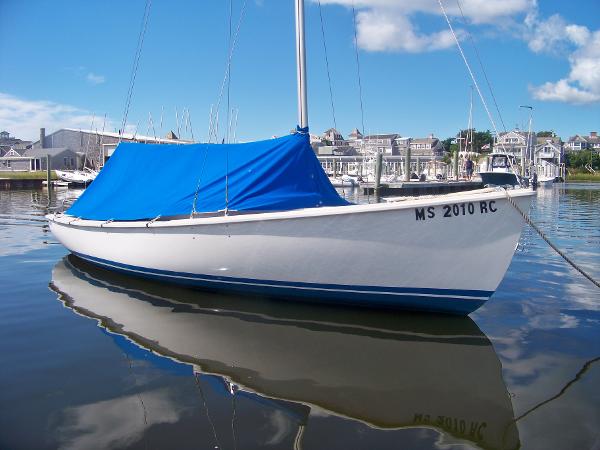
2010 Rhodes Rhodes 19 Centerboard Sailboat
Harwich Port, Massachusetts
Make Rhodes
Model Rhodes 19 Centerboard Sailboat
Category Daysailer Sailboats
Posted Over 1 Month
2010 Rhodes Rhodes 19 Centerboard Sailboat R19 Compass mooring cleat bouble chock kit outboard bracket kit R19 MAINSAIL Jib Sail R19 Boom cockpit tent Pr spreader boots Masthead wind indicator gusher bilge pump kit Fir Extinguisher 2012 Honda 2hp 4 cycle outboard with bracket Anti foulingg bottom paint Blue bottom with blue boot stripe VERY NICE BOAT LIKE NEW OFFERS ENCOURAGED
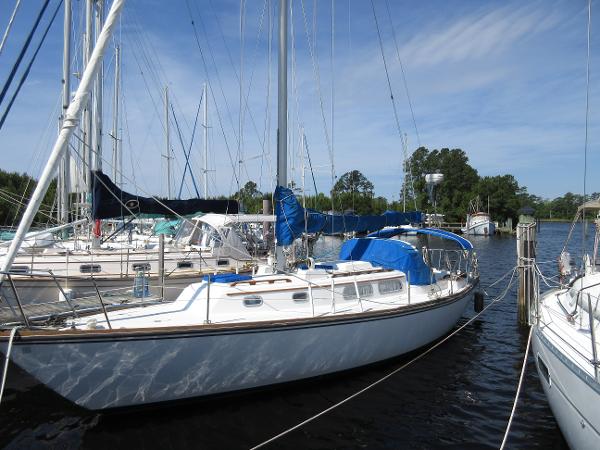
1978 Pearson 35 Centerboard
New Bern, North Carolina
Make Pearson 35
Model Centerboard
Category Racer Boats
1978 Pearson 35 Centerboard SEAQUEL is a well cared for, very sharp and graceful 1978 Pearson 35. She sails beautifully, accelerates quickly and is a very efficient sloop rigged vessel. This boat in beautiful condition and has been constantly upgraded. She shows exactly how the pictures look! This is a golden opportunity to purchase a very well made classic Pearson 35 in beautiful condition! With its’ Center Board keel your draft range is anywhere from 3'9" to 7'6" which allows opportunities to anchor in those great anchorages that others will miss while having great windward performance. If you want a wonderful sailboat, “just buy a Pearson!” Seaquel won't last long.
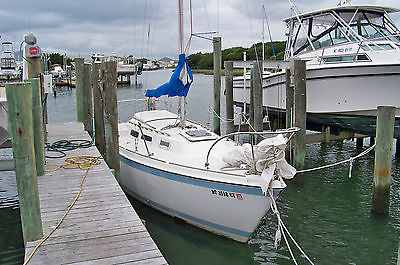
1977 O'Day Sailboat 25ft Centerboard
Morehead City, North Carolina
Length 25.0
1977 O'Day sailboat in very good condition for sale. 5 horsepower Honda long shaft outboard with very low hours. Outboard motor starts on the first pull and brings the boat to hull speed even against current. New high thrust prop on the motor. Includes original prop. Completely new shore power system with Blue Sea ELCI panel and GFCI receptacles. New DC panel and wiring. New standing rigging - replaced all 6 stays with new old stock. The 35ft mast has new wiring, a new Shakespeare antenna, new LED anchor light and new LED running light. Centerboard has a new pendant line. New Saturn bulkhead compass wired with light for night sailing. Hauled out completely scraped and painted this last November '14 with ecominder copper free ablative paint. Rudder has brand new heavy duty guntles, so the rudder is very secure. Working VHF radio. Comes with good mainsail, good hank-on jib. Porta potty in good condition included. Water system is a nice jabsco pump system with a new 25 gallon water tank. Through hull beneath galley replaced last November with a brand new covered flange ball joint with a mounting plate. Has all the anchors and lines you need. This boat is trailer-able. Ready to go! Is a very roomy boat would be great for weekend trips and overnights. Draws 27" with the board up and 5' down. Equipment List:: Anchors VHF radio 50ft shore-power cord 10" brass Lewmar winch handle New water tank New shore power New compass new Shakespeare antenna new masthead light new LED running light new Groco flange valve through-hull Recent Improvements: $250 - Standing rigging replaced with new old stock from another O'Day (in excellent shape). $100 - Rudder guntles have been replaced top and bottom and bolted through the hull - this rudder won't come off. $250 - Through hull beneath galley replaced with Groco flange ball valve, so the one through hull below the waterline is very secure. $250 - New water tank and pressurized water system. $700 - Hauled scraped and painted November 2014. New Saturn bulkhead compass. $500 - New shore power Blue seas AC panel and system with ELCI and GFCI receptacles. New DC panel and wiring. $175 - New masthead light, running light and Shakespeare antenna on top of mast, mast was rewired. $40 - New Pendant Line for centerboard. $200 - New bulkhead Saturn Compass. $100 - New DC panel and wiring including 2 good batteries. $60 - 3 good anchors. Located in Adam's Creek across the Neuse from Oriental Day sailer sailboat liveaboard
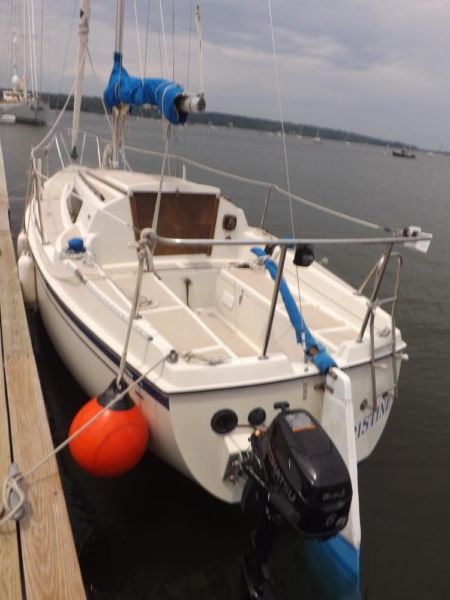
1984 O'Day 26 Centerboard Sailboat
Oyster Bay, New York
O'DAY 1984 26' SAILBOAT includes mooring for the spring/summer season in Oyster Bay, NY!!!! Centerboard makes South Shore Sailing a breeze and you can also pull up to the beach! Great entry level sailboat for daysailing, cruising, or overnight stays on the water. Motivated seller; price is negotiable. Perfect sailing for Long Island Sound or Great South Bay - draws only three feet. Can be easily trailered (no trailer included) with her centerboard keel and mast head rig. Designed for comfort and ease of use. The cabin area can sleep four comfortably. Great shoal draft/centerboard with new 2014 Tohatsu, 6 hp engine, four stroke outboard long shaft, barely broken in with portable, 3 gallon fuel tank. Anodized aluminum mast is deck-stepped. This is a highly manueverable sailer, with ease in comfort, launching and the pedigree of O'Day. LOA: 26 Beam: 8.0 Draft: 2.6 Board Up and 6' Board Down Displacement: 4,800 Ballast 1,850 internal lead Vessel is equipped with Quantum sails: 2011 Quantum main sail 2011 Quantum 135% Genoa 2011 Harken Roller Furler Lazy Jacks and reefing system, yard installed Vessel has double v berth forward w privacy door, port and starboard settees in main cabin, port settee pulls out and forms double berth, quarter aft berth and there is storage under all berths and behind settee backs. Head compartment is fitted w porta-pottie, hanging locker, vanity w sink and lockers above and below. Galley area is starboard aft w two stainless steel sinks, one 20 gallon water tank, one folding table, two burner alcohol stove and deep insulated ice box. Vessel has Horizon VHF radio, bulkhead mounted compass, 12 V DC electric panel, battery 12 v, running lights and interior lights. In addition, horseshoe, throw-able PFD, flares, distress flag, air horn and fire extinguisher. There are dock lines, two boat hooks, and one winch handle. New bottom paint 2015. Photos: www.sellyourboatnow.shutterfly.com
24' 2013 Raven Class Centerboard
Riverhead, New York
Please call boat owner Warren at 631-255-5900. I have 24' Raven Class Sailboat reconditioned totally in 2013 ,Awgrip paint hull & deck with new sails from Doyle Sailmakers,( 2013), Fully rigged ready to go . The trailer has new wheels and springs ,totally reconditioned ,custom to cruise down the highway . Easy show Riverhead, NY .All new hardware, centerboard, seats from Cape Cod Shipbuilding. If interested please leave ph# and I will call promptly!
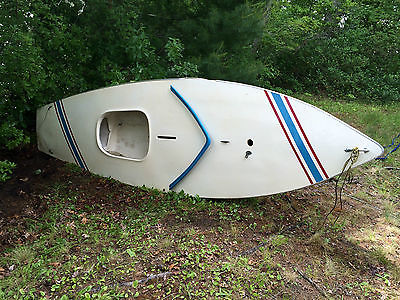
Alcort Sunfish Sailboat Boat, Mast, Sail, ropes, Rudder, and 2 Centerboard s
Mashpee, Massachusetts
Make Alcort Sunfish
Model Alcort Sunfish
Category Sailboats
I paid $1,575 for this boat 7 years ago. It had sat in someones garage for 30 years. It was in fantastic shape when I bought it. It was used 2 times the first year I got it. I had grown up sailing a sunfish and bought it hoping I would use it a lot at the lake in Mashpee Massachusetts summer cottage where it has been stored. It has been stored year round underneath tarps completely covered year round. This sale includes the boat, the sail, the ropes, the mast, 2 centerboards, and the rudder. The rudder was missing the last segment when I bought it-the part you hold on to, so I invented a last segment which worked fine for me. One centerboard is in great shape, the other in ok shape. The one piece of damage is seen clearly in the photos- one piece of metal strapping has peeled away from the edge. I am sure someone who knows what they are doing can bend it back. I would rather not attempt it myself. It was watertight when I sailed it. It is sold as is.It is a great deal.Cape Cod Mashpee on the shore of a lake.

17 ft. Gaff Haven 12 1/2 Sailboat. Centerboard version of the Herreshoff 12 1/2
Grosse Pointe, Michigan
Make Custom Built
Length 17.0
The Haven 12 1/2 is Joel White's centerboard version of the Herresshoff 12 1/2. This boat was built to the highest standards, completed in 2006. It has a white oak keel and steam bent oak frames. It was built with plank on frame construction over molds at each frame with Atlantic White Cedar. The front deck is 3/8" marine plywood with teak marine grade plywood laminated on top and scribed with lines to represent deck planking. The rest of the wood is all mahogany and teak. The gaff rigged sails (main and jib), are from Center Harbor (Maine) sail makers. The metal hardware is all silicone bronze as are all the screws. All the spars are Sitka Spruce, which is very light weight and very strong. She has Sunbrella main and jib sail covers. There is a marine grade deep discharge 12 volt battery which powers Minn-Kota electric trolling motors for auxiliary power. There is also an AM/FM/Marine stereo system with iphone/ipod input and two mounted speakers. A galvanized wire lifting harness is also included. It comes with a custom built galvanized Triad trailer (~2006), which has a custom mast holder and "sail off" capability. New paint and varnish was completed inside and out in April, 2015 using Epifanes Varnish and George Kirby Jr. paint. The boat is located near Detroit, Michigan - worth the trip! $20,000. Reasonable offers considered. Shipping and payment: Cannot deliver boat. Payment required in full at time of purchase.

1981 C&C 40 Centerboard Cruiser/Bristol
Daytona Beach, Florida
Make C&C
Model 40 Centerboard Cruiser/Bristol
1981 C&C 40 Centerboard Cruiser/Bristol PRICE REDUCTION!YOU WILL NOT FIND A BETTER 40' SAILBOAT AT THIS PRICE!!!IF YOU ARE READY TO SAIL TO THE ISLANDS, SO IS THIS BOAT! EQUIPPED AND REAY TO GO!This is your chance to own a RARE & GREAT C & C Performance Cruiser, Centerboard Sloop at a Great Price with TONS of NEW Items! PERFECT LIVE ABOARD!New NS Triple Reef Main Sails (2015)Bottom Painted (March 2015)Engine Serviced: Valves Adjusted, New Thermostats, New Hoses, Injectors Cleaned, Oil Changed, etc. (2015)New Raw Water Pump (2015)Storm Jib Brand New, Never UsedGenny Sail Re-sewn & certified with Sunguard (2015)Most Lines just replaced (2015)New Life Jackets (2014)New 8 1/2 ft. Zodiac PVC Dingy (2015)NEW West Marine Jacob Toilet (April 2015)NEW Macerator Pump (April 2015)NEW Cockpit Bimini (October 2015)
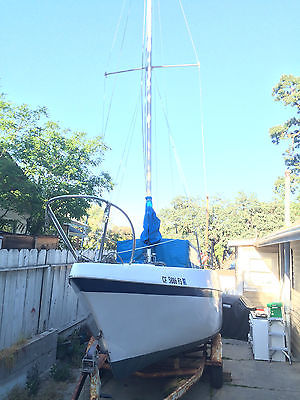
26' Clipper Marine Sailboat
Paso Robles, California
Make Clipper
Model Marine
Length 26.0
For sale is a 26 foot Clipper Sailboat. Great condition, ready to sail. Comes with two main sails, a genoa and a storm jib. Swing keel, extremely easy to tow (folding centerboard and removable mast). Serviced 8hp two stroke engine that starts every time. Pop top to allow for 6 feet of head room. Sleeps four comfortably. Ice box, sink, water bladder, porta-potty, and cabinets for storage. Table folds down to allow for sleeping area. Licensed through Dec. of 2015. Title in hand. Comes with an older trailer (functional but an eyesore) for free.
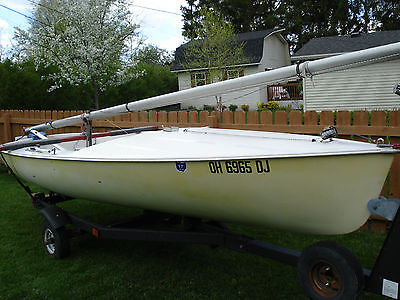
Chrysler Mutineer Sailboat
Make Chrysler
Model Mutineer
Length 15.0
1975 Mutineer Sailboat built by Chrysler Marine. Centerboard day sailor. Hull weight approx. 475 lbs. Made for two sailors but will hold four. Hull good. Most of standing rigging has been replaced with new SST wire. Running rigging mostly all new. Sails professionally cleaned and re-resined 3 seasons ago. Main and jib sail area 150 sq. ft. Roller furling jib. Trailer was reconditioned with new lights, new coupler and swing up trailer jack. Tires OK and rims have bearing buddies. Pick up only - near Dayton Ohio
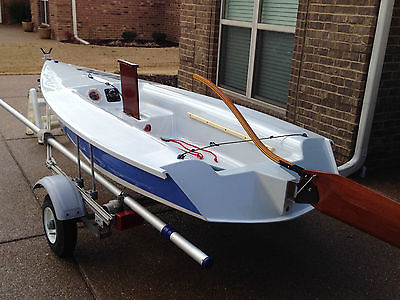
ZUMA Sailboat and Trailer
Jackson, Tennessee
Make Vanguard
Category Dinghies
Length 12.8
This is a beautiful ZUMA sailboat with a Trailex aluminum trailer. It is a Vanguard built boat that has only been sailed a few dozen times. It has been covered or garaged for most of its life, and it shows. As the pictures taken in the last year or so attest, it looks wonderful. The ZUMA was made by the same folks who build the Laser; but the ZUMA, in my opinion, is much nicer to sail with two people than the Laser. It is a fun boat that is not as high in performance as the Laser, but is easier to set up, and requires, perhaps, less athleticism too. It does move along quite nicely. Beginners can sail this boat; or folks like me, with over thirty years of sailing experience, can enjoy it too. The ZUMA is good for any age sailor that has been properly taught. It takes just minutes to set up, and requires little maintenance. It has a zippered luff, so that the sail can be raised and lowered with a halyard; meaning the mast does not have to be lifted in and out every time like a Laser. The boat only weighs 130 pounds and can be towed by most any car out there with a hitch (check your manual, though). Trailer and all, the towing weight is only around 275 pounds; thanks to the lightweight trailer. This boat looks like it is only a year or so old, and comes with nifty extras. The NORTH sail is in wonderful, almost new, shape. But that's not all. I include a virtually new Neil Pryde sail too. Both sails are very nice looking. It has a Harken tiller extension on a beautiful laminated tiller, and the single bulkhead port has been expanded to two, with storage bags in each. The lines are all like new and bright in color. The traveler block set is upgraded to the one piece design from the Laser. This package includes a new rudder cover and a new centerboard storage bag. I include a HAWK wind indicator and other little extras. The SILVA compass was standard on the ZUMA, and is, of course, included. The Trailex aluminum trailer supports the boat by the gunwales to avoid stress on the bottom. The tires (with galvanized rims) are less than two years old, and I will include a brand new spare with galvanized rim. Spare tire is not mounted on trailer; but can be stowed in trunk of car or such. The trailer comes with LED lights, too. There is also a custom Sunbrella boat cover included. The cover, as would be expected, is the one thing that shows the most signs of wear. It has done its job of protecting the boat, though, and should continue to so so for quite some time to come. New covers should be readily available when this one needs replacing. Pictures tell a good story; but here is some additional information regarding those pictures. The sailing pictures were taken in 2014 on the Intracoastal Waterway near Pensacola Beach. Most pictures show the boat before the second port was added. Some ZUMA's had either one or two, for seemingly no rhyme or reason. The boat looks much more balanced with two, and it's handy for extra storage too. Storage bags for the ports are included; along with a small oar that can be stored inside the hull. The oar was sized to fit right through the port. The ZUMA logo on the top of the boat was removed earlier this year. I hated it, and thought the boat looked much more refined without it. I had no intention of selling it when it was removed, but you could always have a sign shop do a logo to pretty much match it, if you were so inclined. The boat has some crazing of the gelcoat here and there, and there are a few scratches, but none of that detracts from the overall beauty of the boat. There is normal wear and tear on the trailer, but once again, it looks like a year or two old package. You have to see it to appreciate it. The boat is in Tennessee and if you are within driving distance, it awaits your inspection. I have sailed for over thirty years and take really good care of my boats. This boat was owned originally by a friend who takes, perhaps, even better care of his boats. It is almost impossible to believe how good this boat looks for its age. Nothing's perfect, but this boat could be a Christmas gift come true for someone wanting to mess about in small boats. New boats of this type start at prices of 5,000 and up; and the Trailex trailer alone sells for about 1,100.00. A spare sail and extras make this all even more worthwhile. I have title papers for both boat and trailer. Please email me with any and all questions. There is video of this boat being sailed also available; if you want to see it in action. The entire package is ready to be towed away by the buyer. I want you to see it, look at the gear, and be completely satisfied before you drive away. You will be pleased.

1980 Pearson 35 Sailboat
Classic 1980 Person 35 w centerboard shoal draft and equipped w Fairclaugh custom canvas cover and 400 lb mooring. On the hard in Oyster Bay, New York - ready for viewing. Well maintained vessel. Masthead sloop w deck stepped mast and aluminum spreader. Equipped w Harken roller furling on jib (new 2004), Main sail (very good condition), Genoa 110 and 135. All sails are in good to very good condition. Lots of storage, great u-shaped aft galley, large sink, expansive counter space makes for ease in entertaining. Mast, standing rigging were replaced in 2003/2004. Summer of 2010 new motor mounts, alternator, water pump, water separator, fuel pump and added 2nd fuel filter. 2014 new bilger pump and fresh water pump, 2010 new heat exchanger, muffler system and 6 gallon hot water tank as well and black water holding tank, head and pipiong. 2007/2008 replaced Spectra line and rollers for raising centerboard. Vessel equipped w Garman GPS Model 500 (purchased 2011), VHF radio, depth sounder and speed indicator, hot/cold pressurized water, shower, new (2004) Lerwmar external mount anchor windlass, fresh water wash down in anchor locker, private bathoroom has head, shower and sink. Must see. Well maintained vessel. Make an offer. Owner negotiable. Photos: www.sellyourboatnow.shutterfly.com Contact: Steve/Patty (631)896-6212

Traditional Beetle Cat Sailboat
Rochester, Massachusetts
Traditional beetle cat sailboat. Hull number 1024 which means it is from the late sixties. Made of wood and in very good shape. Hull has been refastened with stainless steel in the recent past. Needs new canvas and some deck repair. There was a hole in one plank and a Dutchman repair was started. It needs the new piece installed. I cannot stress what good shape the hull is in. I would keep it but I need the room. Some hardware and centerboard included. Willing to negotiate.

18’ American Sailboat & Trailer
Vincentown, New Jersey
The American 18 Daysailer is ideal for those who are seeking a spacious and comfortable daysailer which is also designed for speed and performance. Design features include a self bailing cockpit, molded in drink cooler storage areas, three storage compartments, kickup rudder and centerboard, adjustable jib tracks, Harken hardware, and stainless rigging. The American 18 is constructed of hand-laid fiberglass with positive foam floatation for a durable and safe boat. The wide beam and flat bottom planing hull allow for exceptional performance in a light breeze or in a heavy wind. This boat is designed to sail flat with minimal heel. Seats 6 people. Includes bumpers, main sail, jib sail, custom seat cushions, motor mount and swim ladder in excellent condition. Boat has been kept in dry storage and mainly used in fresh water. Trailer is in excellent condition and includes spare tire.

1971 Bristol 30' Sailboat
Branford, Connecticut
You are looking at a 1971 Bristol 30’ Sailboat. This sailboat is ready to sail! It just needs some cleaning, maybe some paint on the top deck and just some overall TLC. This boat comes with some incredible features not found on most other sailboats. Who can argue with a loaded classic Bristol! Features: Shoal Keel with Centerboard Atomic 4 Gas Engine Updated with Electronic Ignition Updated with Electric Fuel Pump Three NEW self-tailing winches Raymarine Speed, Depth, Wind and Autopilot Used only once to test function Roller Furling Sails – Main, Jib and Spinnaker with Pole Alcohol stove/sink and ice box Bottom barrier coated and painted Sleeps 6 This boat is on land and needs to sell. The stands are not included and there is no trailer. The price listed is best offer, but would like to get as much money back on the investment as possible. Check the market, no other Bristol is this cheap READY TO SAIL. Put it in the water and catch some wind! Please call Pete at (203) 494-4570. The boat can be seen in Branford, CT. Please call to schedule appointment.
Narrow Results
Current search reset all.
- Keyword: centerboard sailboat
- Pearson (4)
- Marlow-Hunter (2)
- Precision (2)
- Vanguard (2)
- Alcort Sunfish (1)
- Chrysler (1)
- Clipper (1)
- Crosby Classic Catboat (1)
- Custom Built (1)
- Custom Flex (1)
- Force 5 (1)
- Fulmar 19 (1)
- HERITAGE YACHT CORP (1)
- Haven 12-1/2 (1)
- Herreshoff (1)
- Hinckley (1)
- Lippincott Boat Works (1)
- Macgregor (1)
- Macgregor 26S (1)
- Pearson 35 (1)
- Stornoway (1)
- Windjammer Yachts (1)
- Sailboats (10)
- Daysailer Sailboats (9)
- Cruiser Motorcycles (5)
- Dinghies (3)
- Racer Boats (2)
- Sloop Sailboats (2)
- Cruiser Sailboats (1)
- Florida (23)
- Massachusetts (7)
- New York (6)
- Connecticut (4)
- Indiana (4)
- New Jersey (4)
- California (3)
- North Carolina (3)
- South Carolina (3)
- Maryland (2)
- Michigan (2)
- Tennessee (2)
- Wisconsin (2)
- Georgia (1)
- Kentucky (1)
- Louisiana (1)
- Minnesota (1)
- Mississippi (1)
- Missouri (1)
- New Hampshire (1)
- Washington (1)
- POP Yachts (6)
- Search Title Only
- Has Picture
- Include Sold Listings
Showcase Ads

2007 Sea Ray 205 Sport
Bellaire, MI

1988 Sea Ray Seville
El Toro, CA

2006 Hobie Getaway
Washington Park, NC

2015 Malibu Wakesetter 22 MXZ
Seattle, WA

2017 Crownline Eclipse E2 XS
Chicopee, MA

1995 Pro-Line 231 WA
Sarasota, FL

2013 Sailfish 290 CC
Kenneth City, FL
Create Alert
Please, name this search
Select Interval
Alert Successfully Created

IMAGES
VIDEO
COMMENTS
Rake the mast to spec. Sail the boat flat. Bear away in the puffs when sailing deep, before the boat begins to heel excessively. Always steer for balance. However, a centerboard or daggerboard adds an additional trim tool that is often forgotten. When the centerboard first begins to swing up, it moves more aft than up.
Ive sailed on a couple of these sloops and like the way they look and sail. The boats heritage gives it a loyal following (a good thing to look for in any used boat). Pros: Storied design, with a good deck layout and comfortable motion. Cons: Finish quality varies greatly as many were owner-completed. Factory interior is pretty basic. 3. Tartan ...
A centerboard is a retractable appendage that pivots in and out of a slot (centerboard trunk) in the hull/keel of a sailboat. Having the ability to raise and lower the centerboard allows the the boat to operate in shallow waters when lifted, while maintaining good upwind sailing characteristics with the centerboard down.
centerboard preowned sailboats for sale by owner. centerboard used sailboats for sale by owner. Home. Register & Post. View All Sailboats. Search. ... Featured Sailboats (all): 44' Bavaria 44 Panama Linton Bay Asking $85,000. 30' Rawson 30 West Palm, Florida Asking $19,500. 42' Beneteau Oceanis 42 center cockpit
Centerboard Sailboat Characteristics. Centerboard sailboats are typically less than 25 feet in length and designed for shallow water. In fact, centerboard boats are perfect for shallow water. Cruising in lakes and rivers is a joy with a centerboard boat, as the board can be retracted for towing, beaching, or skimming over shallow water.
A sailboat centerboard is a retractable keel or fin located in the center of the boat's hull. It provides stability by counteracting lateral forces from wind, allowing the vessel to sail closer to the wind. The centerboard can be raised or lowered based on water depth and sailing conditions, optimizing performance and preventing damage.
Most small sailboats under 20 feet in this list are time-tested, easy to rig, simple to sail, extremely fun, and perfect either for solo sailing or for sailing with friends and family. ... The centerboard model is designed with a powerful sailplane that remains balanced as a result of the fiberglass centerboard, the stable hull form, and the ...
In the case of the Seward 46RK, the daggerboard, or lifting keel, is comprised of a solid polyester composite, with a fiberglass skin and a series of stainless rods running the length of the foil to both increase stiffness and carry a 7,500lb cast-lead ballast bulb. An electric motor, operated by a set of buttons at the mast, raises and lowers ...
A centreboard or centerboard (US) is a retractable hull appendage which pivots out of a slot in the hull of a sailboat, known as a centreboard trunk (UK) or centerboard case (US). The retractability allows the centreboard to be raised to operate in shallow waters, to move the centre of lateral resistance (offsetting changes to the sailplan that move the centre of effort aft), to reduce drag ...
The 30 feet of waterline quickly increases as the boat assumes sailing trim. Its well-proportioned, 11-foot, 3-inch beam was considered broad in its time. All of the boats 9,000 pounds of ballast is in the fixed keel, so that even with the centerboard up, the 41 is a very stable boat.
To help you out, I'll list the pros and cons of fixed vs. swing keels on sailboats in this article. Fixed keels offer better performance than swing keels and centerboards, since they are more comfortable and faster. They require less maintenance. However, swing keels offer a low draft, and are less prone to damage when running aground.
Built at first with a fixed keel with an optional centerboard, orders for the keel/centerboard version outstripped the original and more centerboard versions were built. If you're looking for one, make sure it's the right version. Lyle Hess and Jerry Montgomery designed the Montgomery 17 as a cruising capable, trailerable boat.
Support Lady K - http://www.patreon.com/ladyksailingOr http://www.ladyksailing.com/team-kTartan Tartan 37 Centerboard Sailboat Cruising SailboatPhoto Credit:...
How to Choose Between a Daggerboard and a Centerboard for Your Sailboat. Choosing the right type of board for your sailboat is a crucial decision that can greatly impact your sailing experience. Two popular options are the daggerboard and the centerboard, each with its own unique advantages and considerations. In this blog post, we will delve ...
A popular trailerable centerboard sailboat is the MacGregor 26, which with its water ballast has the advantages of centerboard boats but not all the disadvantages. Disadvantages of a Centerboard: Provides no (unweighted board) or less (weighted board) ballast, compared to a fixed keel, to resist capsizing and ensure recovery from a capsize ...
As this board was a thin flat plate, this performance was rather poor, consistent with the excessive leeway (115? tacking angles) and noticeable lee helm of the vessel. A thicker, more effective centerboard would not fit the narrow centerboard slot of the vessel.
Both carry NorseBoat's distinctive looking carbon fiber gaff-rigged mast with main and jib (a sprit-set drifter is optional), and come with a ballasted stub keel and centerboard. Because of its lightweight design, the boat can be rowed and is easily trailered. $36,000 (starting), 902-659-2790, norseboat.com.
You'll find them wherever the water is shallow. Read this and weep: in 1970, a Tartan 34, complete with sails, cost about $22,000. By 1975, the price had gone all the way up to $29,000. Today, equipped with more modern equipment, the boat would cost $100,000 to build.
The centerboard doesn't sacrifice performance or safety, in fact, it can enhance performance when it comes to downwind sailing. Another advantage of a centerboard is the expanded possibilities to find docking in marinas that would otherwise be too shallow for a fixed keel sailboat.
The majority of trailerable sailboats have a centerboard or swing keel that retracts for towing and beaching. Some vessels have shorter displacement keels or fin keels. Beam. The maximum allowable for a trailerable sailboat is 8 ft 6 in. This is because these dimensions are the maximum limit for standard trailers on American roads.
The International Lightning Get The Best Of Both Worlds Without Compromising Either One The Lightning, a 19 foot trailerable centerboard sloop, was originally designed by Sparkman & Stephens as an affordable family day-sailor and racing boat. She has evolved into one of the most popular and competitive one-design racing classes in the world. Awarded ISAF […]
Although we could point the boat slightly higher with the 200-pound centerboard lowered, the most noticeable effect of lowering the board was a stiffer ride and a reduced angle of heel. Conclusion. Given the anemic state of the new sailboat market, J/Boats initially expected to sell one J/95 a month until buyers hopped off the fence.
2010 Rhodes Rhodes 19 Centerboard Sailboat. $19,900. Harwich Port, Massachusetts. Year 2010. Make Rhodes. Model Rhodes 19 Centerboard Sailboat. Category Daysailer Sailboats. Length 19'. Posted Over 1 Month.